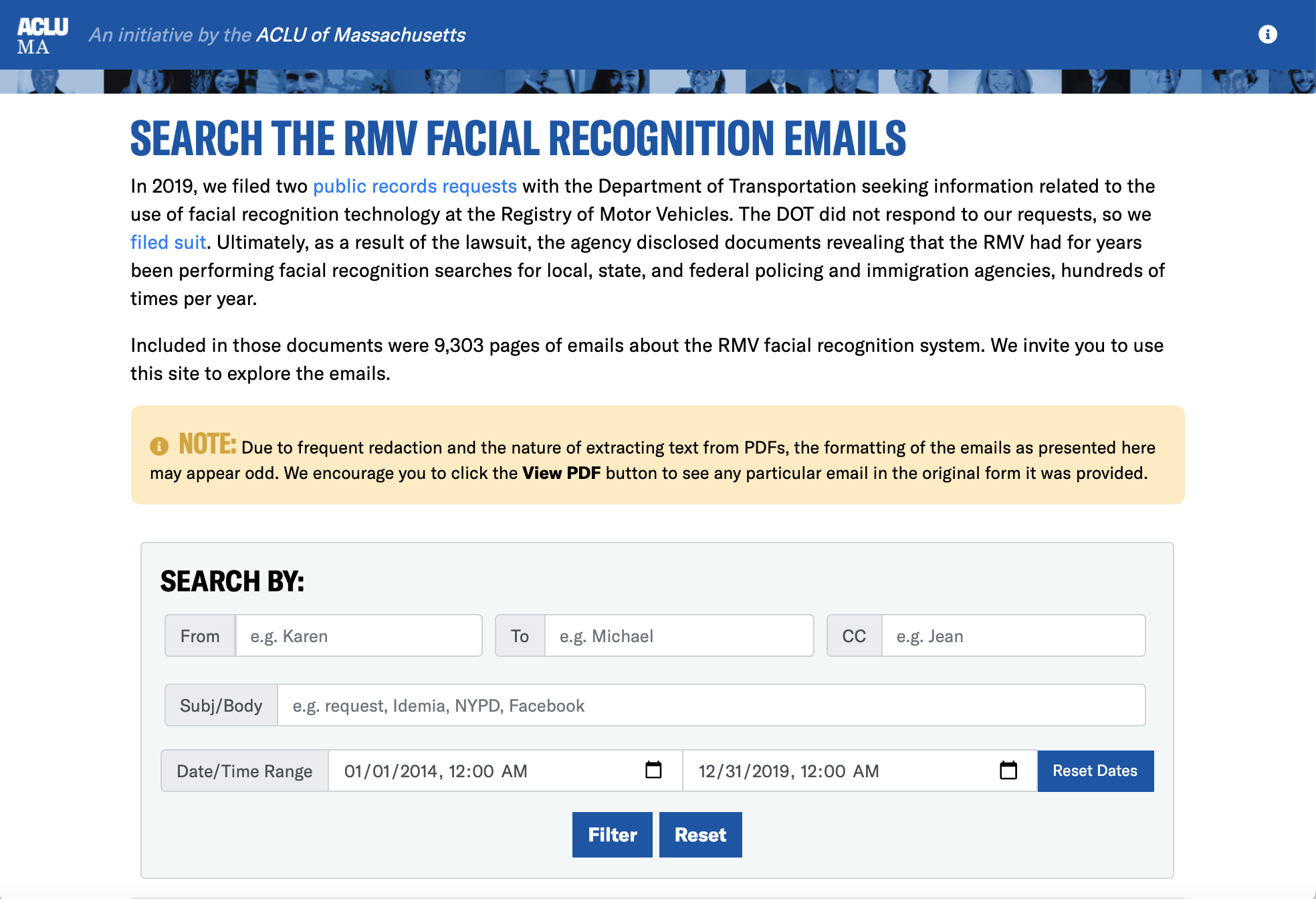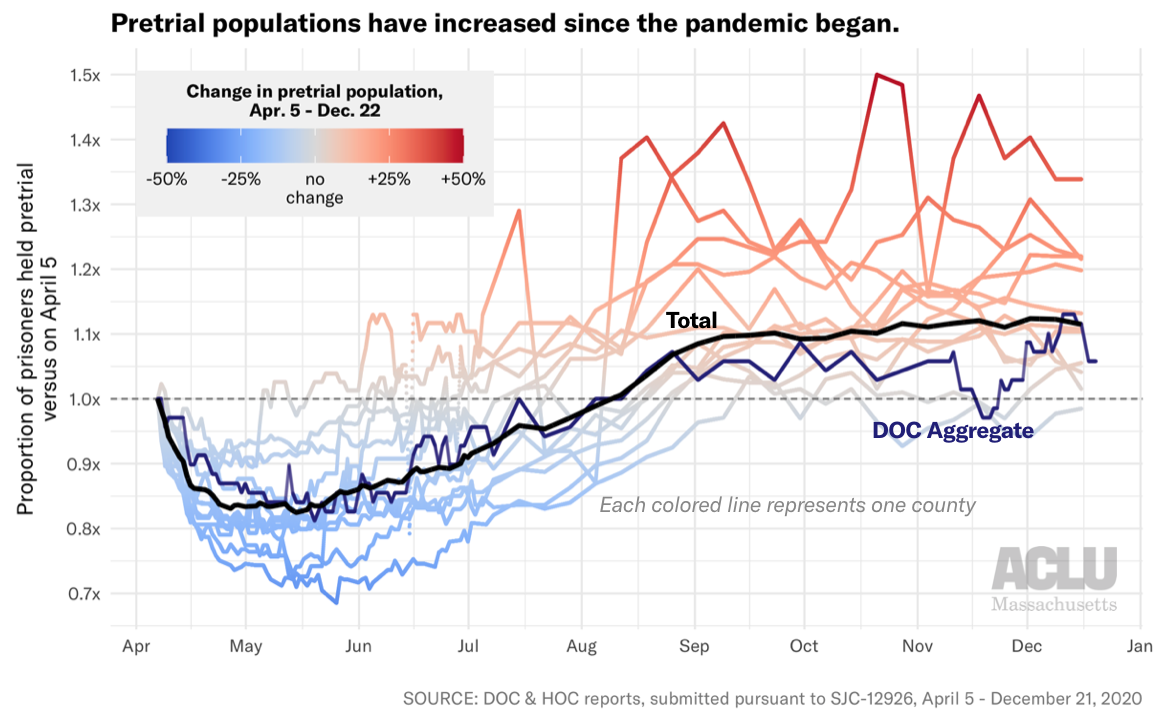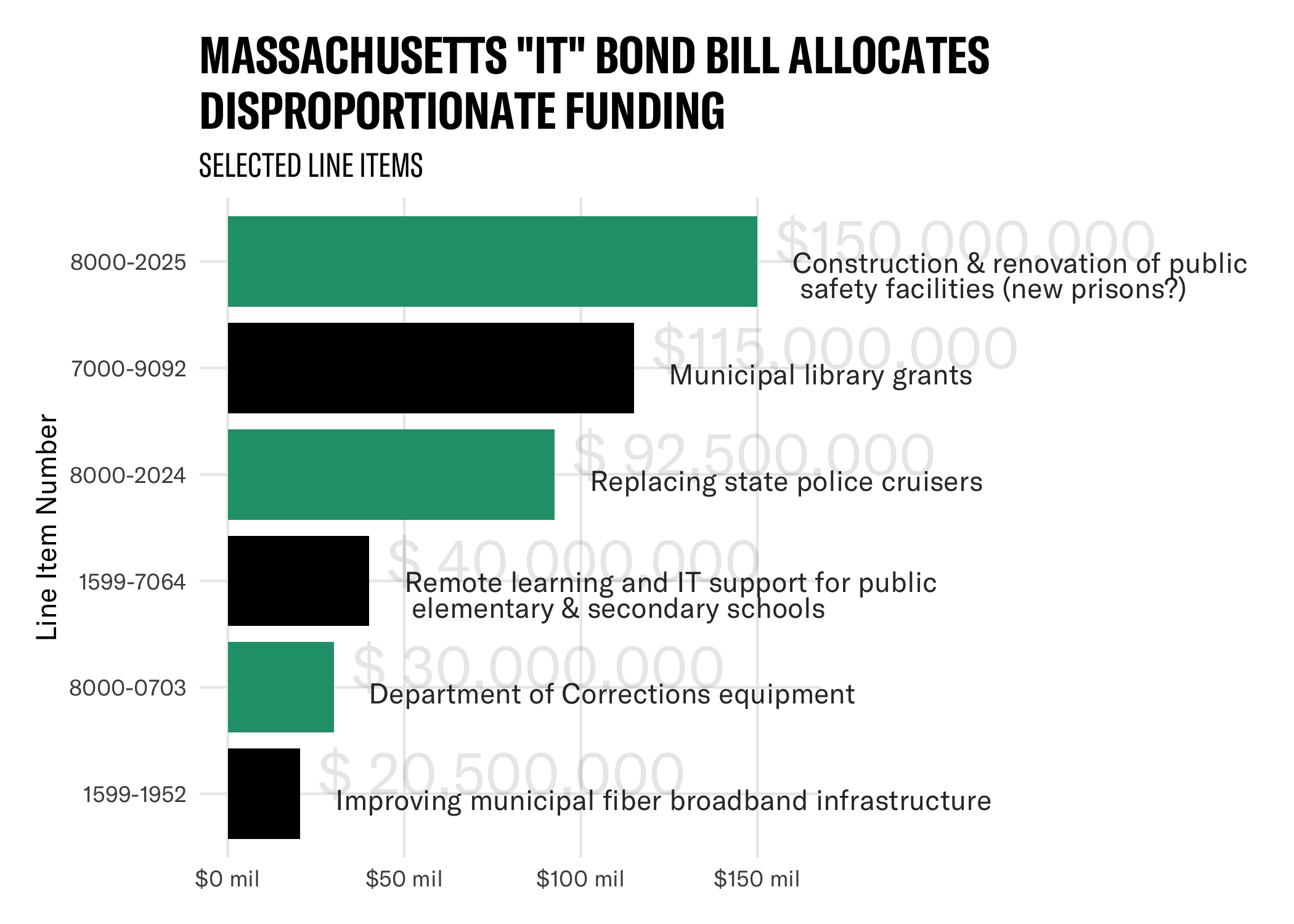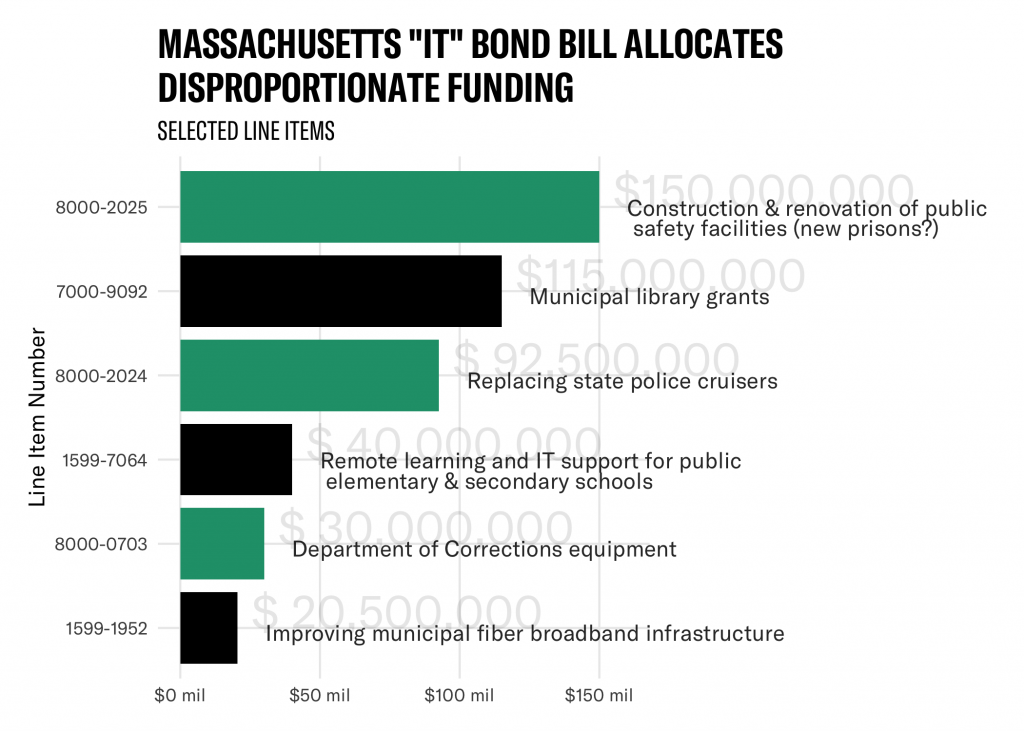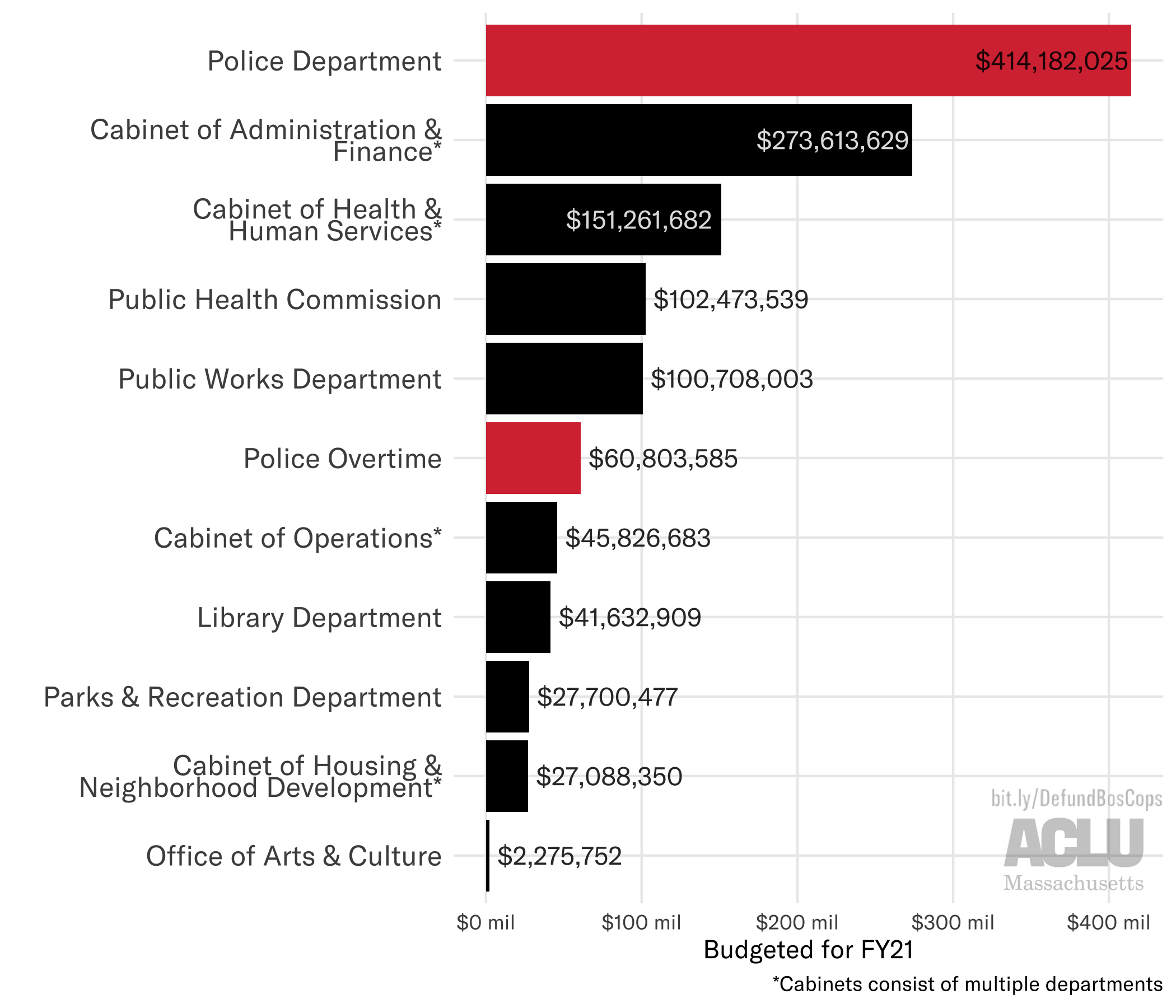More of the Same: Unpacking the 2022 Boston Police Budget
Get caught up with last year’s Data for Justice analysis of the BPD budget, and other work around policing in Massachusetts.
Last month, Boston’s Acting Mayor Kim Janey released her recommended City budget for the upcoming 2022 fiscal year (FY). This budget claims to double down on reducing Boston police overtime, deepening last year’s $12 million budget cut by an additional $4.9 million.
The problem? As recent ACLU analysis shows, without a simultaneous commitment to reining in the power of police unions and penalizing Boston Police Department (BPD) budgetary overages, this “cut” will simply never come to be. Taken together with the fact that Mayor Janey’s recommendation doesn’t really touch the $355 million budgeted for non-overtime policing and otherwise ignores advocates’ calls to divest from police, the FY22 BPD budget is effectively unchanged from years past.
New analysis by the ACLU of Massachusetts unpacks the Boston Police Department budget – again – making it clear that it is effectively no smaller than previous years’ budgets.
The proposed Boston police budget is more of the same.
Numbers show that Mayor Janey’s proposed BPD budget is not a departure from previous BPD budgets. Despite misleading claims around reallocating police overtime, next year’s budget will maintain the status quo in terms of the overall BPD budget, the size of the force, and more.

The BPD budget is still the second-largest line item in the whole city, second only to Boston Public Schools. It is still 1.5x larger than the Cabinet of Administration and Finance (which constitutes 17 individual departments), 9x larger than the Library Department, and 110x larger than the Office of Arts and Culture. The newly-created Office of Police Accountability and Transparency is but a drop in the bucket – for comparison, it’s just over half of the annual BPD clothing allowance ($1.9 million proposed for FY22).
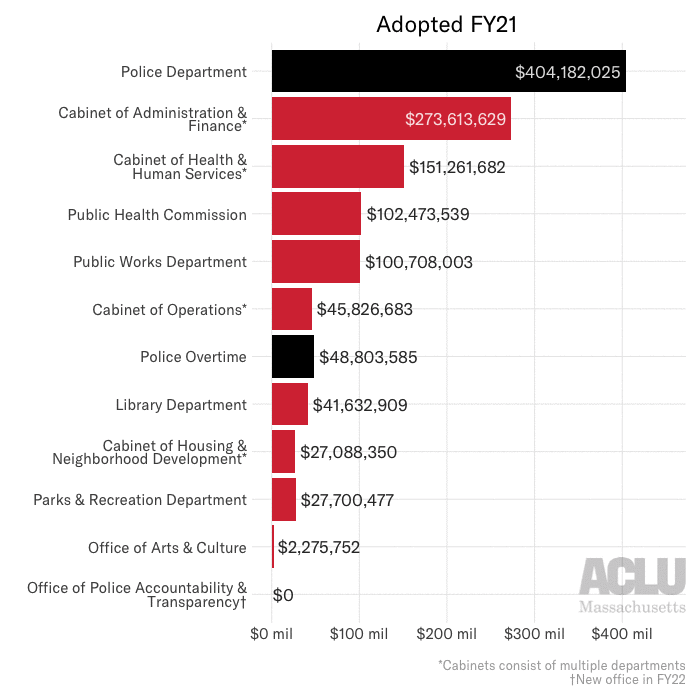
In FY20, Boston police employees were still paid almost $58,000 more than non-BPD City employees – averaging $132,000 in yearly earnings – and over 500 BPD employees still made more than Boston’s Mayor (519 this time).
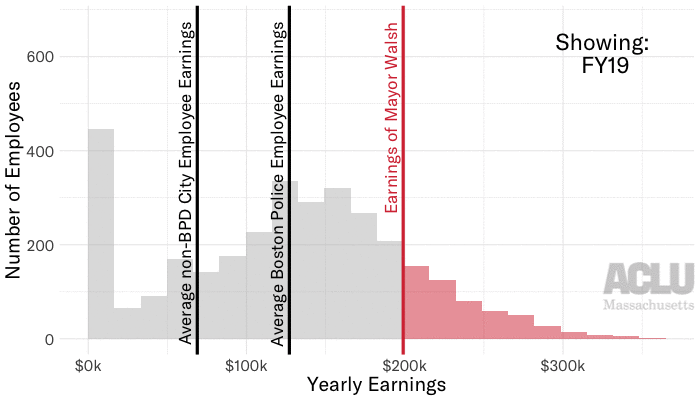
Actually, BPD paychecks swelled even larger. Among the top 20 BPD earners, almost all of them made more in FY20 than they did in FY19:

And while the status quo is upheld, the true causes of exorbitant police budgets go unaddressed.
The $22 million “cut” to overtime means… nothing.
Though the mayor’s office is trying to pass it off as a $21.9 million cut, it’s important to note that the BPD overtime budget cut is actually only $4.9 million – from $48.8 million allocated last year to $43.9 million allocated this year. The $22 million figure is not the budgetary difference, but rather the difference from the FY21 projected spending ($65.8 million, according to the BPD).
But, even more fundamentally, it’s critical to debunk a central myth that underlies Mayor Janey’s BPD budget: that the City budget as it stands currently has any power over police overtime spending. Serious contractual and legal changes are needed – largely changes the mayor can make – before any police budget cuts can be meaningful. As laid out in a recent ACLU of Massachusetts analysis, the City’s current interpretation of an exception in the Boston Charter means that the BPD has no guardrails stopping it from grossly overspending.
This blank check comes at a mighty cost: projections of FY21 spending show police overtime is estimated to go $20 million over budget by the end of June.
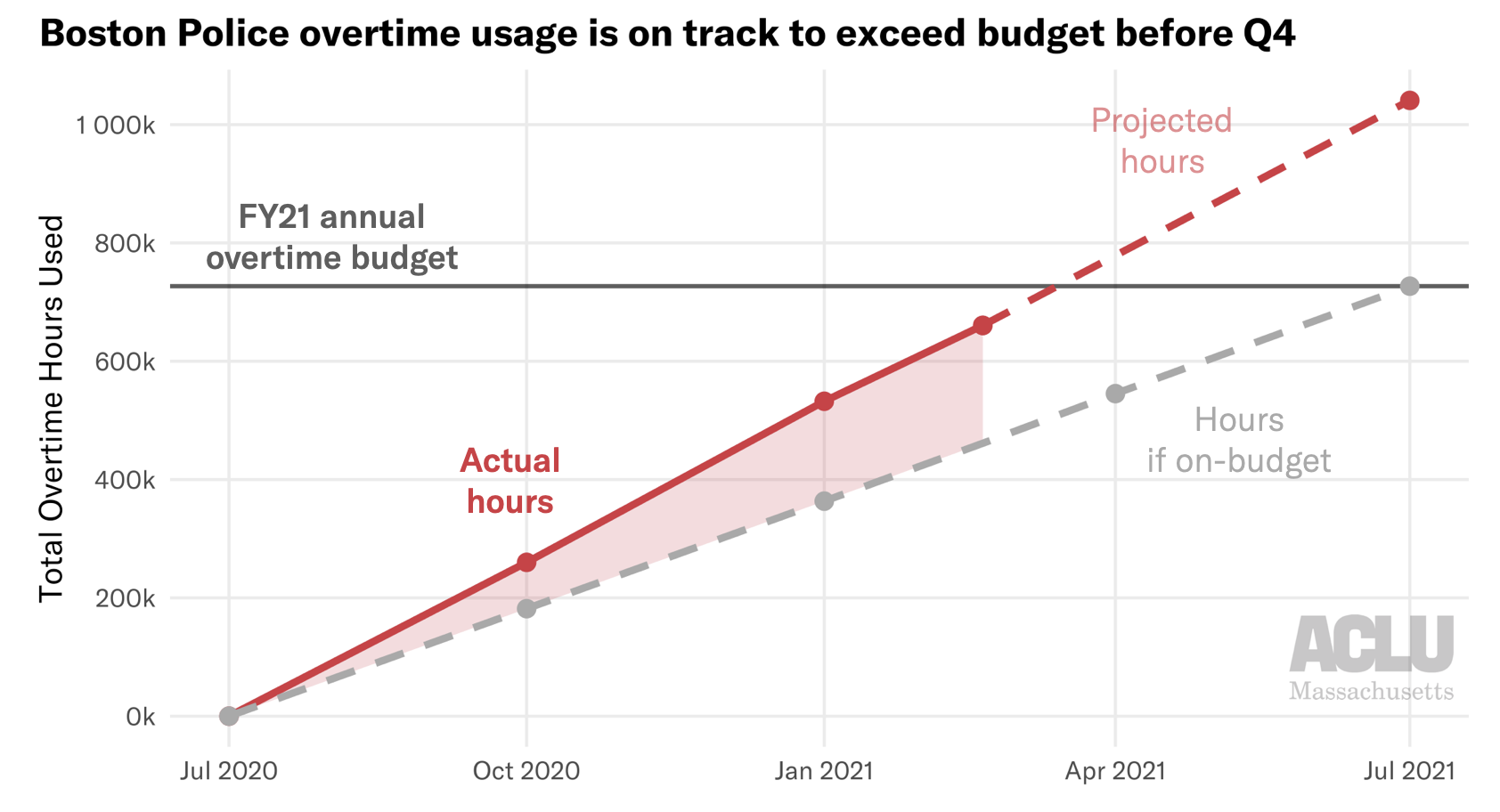
If the BPD couldn’t actualize a $12 million overtime cut during a year when sports stadiums stayed empty and almost all public events were either cancelled or went virtual, why would they be able to actualize a $22 million cut in post-pandemic Boston? It is foolish for the City to expect a different outcome the second time around.
Without taking action that actually changes the system within which the BPD currently operates, the mayoral administration’s rhetoric around reallocating police overtime in next year’s budget is just that: empty rhetoric.
Mayor Janey’s “solution” to overtime will exacerbate the problem.
The Mayor’s recommended budget proposes hiring at least 50 more cops as a means of decreasing overtime spending. This idea is not new among those who would politically benefit from a more powerful police department; Boston City Councilors Ed Flynn and Annissa Essaibi George, as well as the Boston Police Patrolmen’s Association, frequently push to increase the size of the police force. But this solution, too, is based on a myth: that Boston’s police overtime problem is caused by too few police in the ranks. This is untrue; Boston’s police overtime problem is caused by exploitative and unsupervised policing practices that allow the BPD to bleed funds from the City.
Especially when considering the OT problem as a whole – from four hours of pay for 15 minute court appearances, to the Department’s inability to explain the cause of increased injury and sickness even predating COVID-19, to their reluctance to open up administrative positions to civilians, to the secrecy over the minimum staffing level formula – it becomes clear that overtime is not an issue of how many officers are clocking in.
Indeed, historical Boston budget data show that there has been no correlation between a larger police force and lower police overtime spending over the past decade. Some years when the force grew saw higher OT expenditures (e.g., 2014, 2020), and some years when the force shrunk saw lower OT costs (e.g., 2016, 2018). This isn’t surprising: more police lead to more extended tours and more court overtime – and new personnel aren’t necessarily assigned to the units using the most replacement OT.
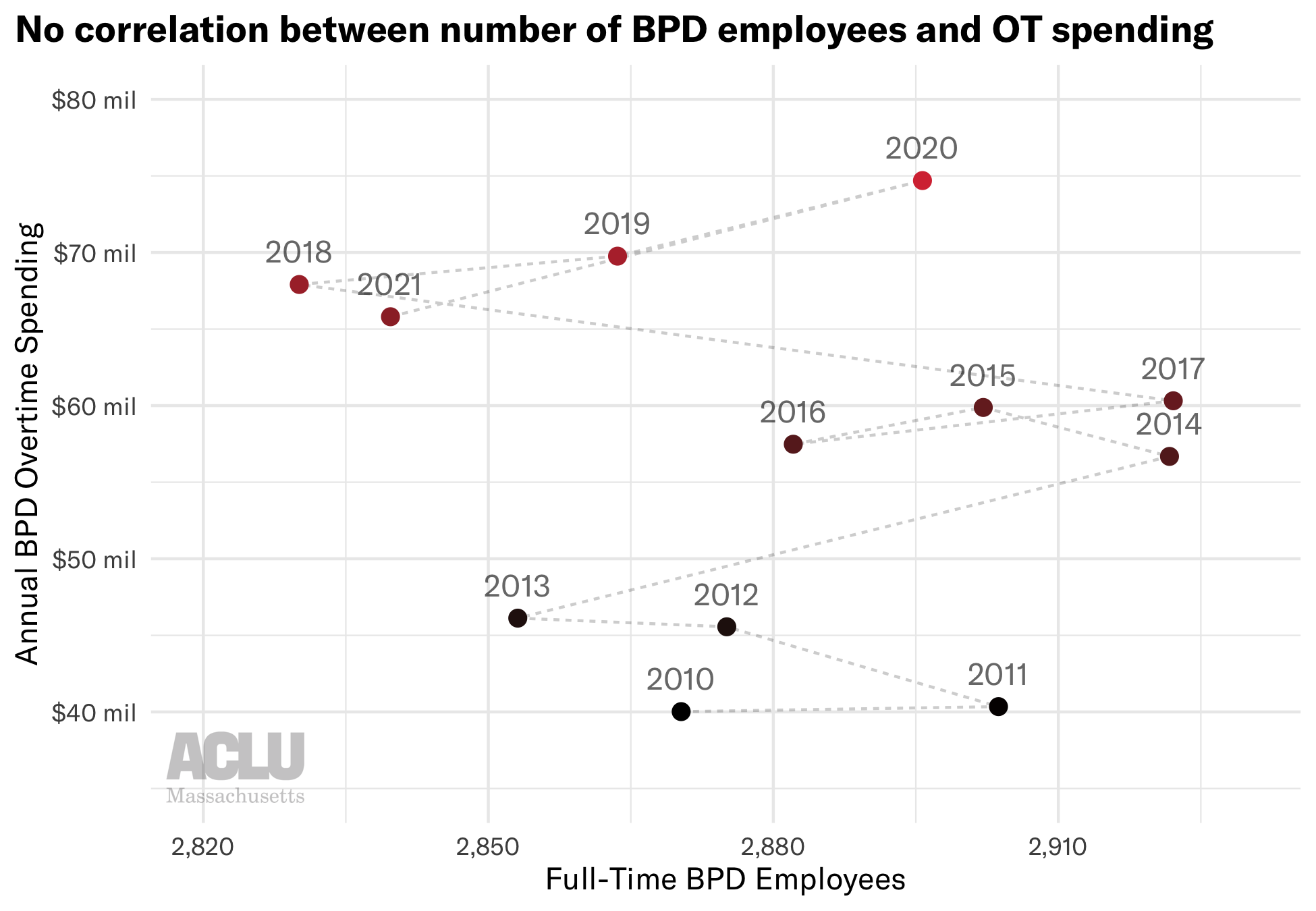
All in all, hiring more officers would do nothing to resolve the BPD’s overtime problem… or to address the remaining hundreds of millions of dollars allocated to the BPD.
Overtime is just the tip of the iceberg.
Critically, Mayor Janey’s focus on cutting only overtime fails to address the whopping $355 million still allocated to the Boston police for non-overtime expenses. She makes no attempt to reduce BRIC funding, cut spending on military equipment, civilianize traffic enforcement, reduce funds for the Youth Violence Strike Force (“gang unit”), or adopt other recommendations urged by community groups.
What’s worse, Mayor Janey’s recommendation wholly ignores the harm that policing already causes to Black and brown communities across Boston, and that community leaders have been protesting for decades. The City’s vague proposal for “alternative policing,” which will work with the BPD, isn’t an acceptable alternative. As the DefundBosCops coalition emphasizes, we need to reroute funds and power into alternative safety initiatives, not just revamped policing. More boots on the ground will solve neither our fiscal dilemma, nor our ongoing local problems with violent and discriminatory policing.
In Boston, police overtime has become smoke and mirrors which distract from more important and urgent policing problems in the City.
Our vision for reinvesting police budgets should not stop at marginal and meaningless budget cuts – and certainly should not include increasing the number of police officers. What we need are new executive priorities that open the door to true budgetary and policy accountability from the police. Only then will efforts to divest from policing and reinvest in community initiatives even be feasible in Boston.
Yet in the shadow of a year of unprecedented international activism around racist police violence and renewed public scrutiny on exorbitant police budgets, the Mayor’s recommended budget shows that Boston taxpayers are about to foot the bill for yet another year of harmful policing.
The mayor’s office must systematically transform the nature of police funding in Boston by committing to strong reforms in police union contracts, and by explicitly adopting a more conservative interpretation of the overspending exception in the City Charter. Last year, then-Councilor Kim Janey called upon the Mayor to cut the BPD budget by 10 percent; this year, she has the power to that, and more, herself.
Additionally, the Boston City Council must reject Mayor Janey’s recommended budget, instead pushing for a budget that actually divests from police spending beyond just overtime, rejects any new police hires, and truly reinvests in community initiatives.
When it comes to police spending in Boston, we can no longer accept more of the same.
What to do about it:
- Boston residents: Take and share the Boston People’s Budget survey to voice your priorities for where taxpayer dollars should go in the City of Boston
- Follow Muslim Justice League and watch #DefundBosCops on Twitter and Instagram
- Email and call Mayor Kim Janey and the Boston City Council to vocalize your support for smaller police budgets, transparency around police contract negotiations, and consequences for police overspending.
- Sign up to testify at Boston City Council hearings on the budget to urge the Council to reject the proposed BPD budget:
- Monday, May 10, 2021, 2 PM ET: Hearing on the Boston Police Department
- Wednesday, May 26, 2021, 3 PM ET: Carryover Hearing on the Boston Police Department
- Thursday, June 3, 2021, 6 PM ET: Dedicated Public Testimony
Where do these data come from?
- Boston City Council documents
- Data on BPD OT usage presented at March 12 Boston City Council hearing
- Boston City budget website
- Overview of proposed citywide FY22 operating budget
- Boston public safety cabinet (including the office of emergency management, fire department, and police department) adopted FY07-21 and proposed FY22 budget, including line items by accounts payable, and list of department personnel & salaries
- Boston’s open data portal
- Proposed and adopted operating budgets from 2020 and 2021, broken down by cabinet, department, and program
- City of Boston 2020 employee earnings report
This analysis benefitted from feedback and input from members of the Muslim Justice League, the Youth Justice and Power Union, and the Building Up People Not Prisons Coalition.
A Mayor’s Roadmap to Curb Boston Police Overtime
New to Data for Justice? Get caught up with our 2020 report on the Boston Police budget and other work on policing in Massachusetts.
Boston’s Acting Mayor Kim Janey just this week proposed a new budget for the coming fiscal year: one which maintains a slightly reduced allocation for police overtime. But as we look to the future of policing budgets, we still have much to learn from the past.
Last June, facing monumental pressure from local advocates and community members, the Boston City Council approved a City budget that “cut” the Boston Police Department’s gargantuan overtime allowance by 20 percent – from $60 million to $48 million. Not even a year later, that “cut” has been exposed as an empty promise.
On March 12, the Boston City council held its third quarterly hearing to follow up on how the BPD is reducing overtime costs. The update was bleak: just eight months into fiscal year 2021 (FY21), data show the BPD has already blown through almost the entirety of its $48 million overtime budget – setting itself up to finish out the fiscal year $20 million over budget.
This debacle has made one thing quite clear: when it comes to reining in police spending in Boston, the budget as defined by the City Council is effectively irrelevant. This is due to both (1) a century-old exception in the City Charter that writes the Police Department a blank check, and (2) the fact that many aspects of policing policy are tied up within police union contracts. So who is it that holds the power to actually affect change? TL;DR: it’s the mayor.
In a new analysis, the ACLU of Massachusetts dives deeper into the issue of overtime within the Boston Police Department and how the Mayor of Boston might be able to finally address it. We set out to answer the following questions:
- Just how big is the BPD’s FY21 overtime overage?
- Why does the City let police overtime spending go over budget at all?
- What factors contribute to overtime spending?
- How can we actually fix it?
Access and share this blog published in the form of a report here.
Just how big is the BPD’s FY21 overtime overage?
Since we are only three quarters of the way through FY21 (the fiscal year in Boston goes from July 1 through June 30), we can’t know how much the BPD will ultimately go over their overtime budget. However, current projections show an extreme overage, to the tune of more than 300,000 hours.
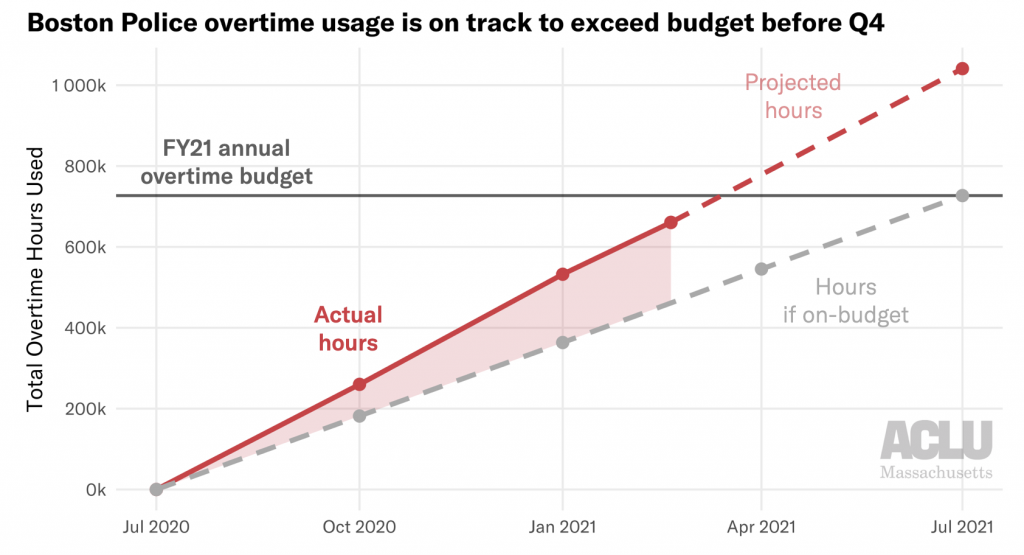
Indeed, if the current rate of overtime usage continues through the end of FY21, BPD will close out the year with a whopping 1 million overtime hours – 30 percent above the budgeted 727,000 hours. With an hourly overtime rate of approximately 66 dollars an hour, that overage translates to about $20 million of unbudgeted spending that the City will have to cough up. (The BPD itself predicts an overage of $15 million, but that would require a decrease in the rate of OT usage over the next three months – an unlikely outcome.)
It’s hard to overstate how far these taxpayer dollars could go if they were put elsewhere. The projected $20 million excess is about half of the FY21 budget for the Library Department and is 8 times larger than the entire FY21 budget for the Office of Health & Human Services. Actually, the projected $20 million excess is larger than the FY21 budgets of the following 10 City departments combined:
- Veterans’ Engagement ($4.6 million)
- Neighborhood Services ($4.1 million)
- Environment ($3.2 million)
- Health & Human Services ($2.4 million)
- Arts & Culture ($2.2 million)
- Immigrant Advancement ($1.1 million)
- Human Rights ($500,000)
- Women’s Advancement ($460,000)
- Fair Housing & Equity ($320,000)
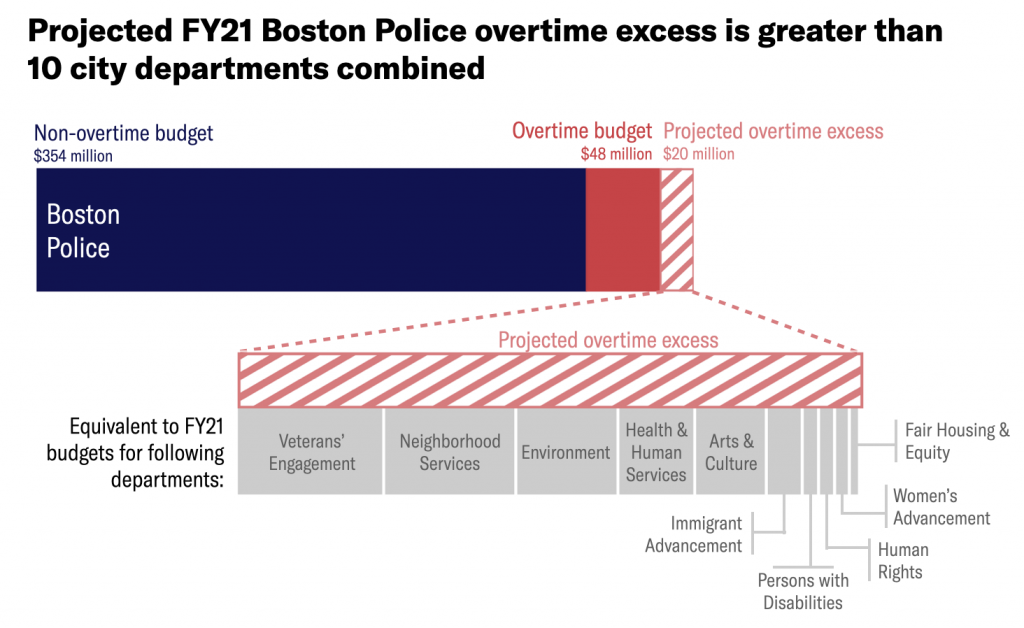
These numbers make it clear that the Boston Police Department is a budgetary parasite, aggressively hoarding taxpayer funds that are sorely needed by other City offices that provide support to communities.
So, how is it that the police are allowed to go over their budget so egregiously?
Why does the City let police overtime spending go over budget at all?
Historically, the Police Department has seen by far the largest overtime overages of any City department. In FY19, for instance, overtime spending went $10.4 million over budget. No other department came close:
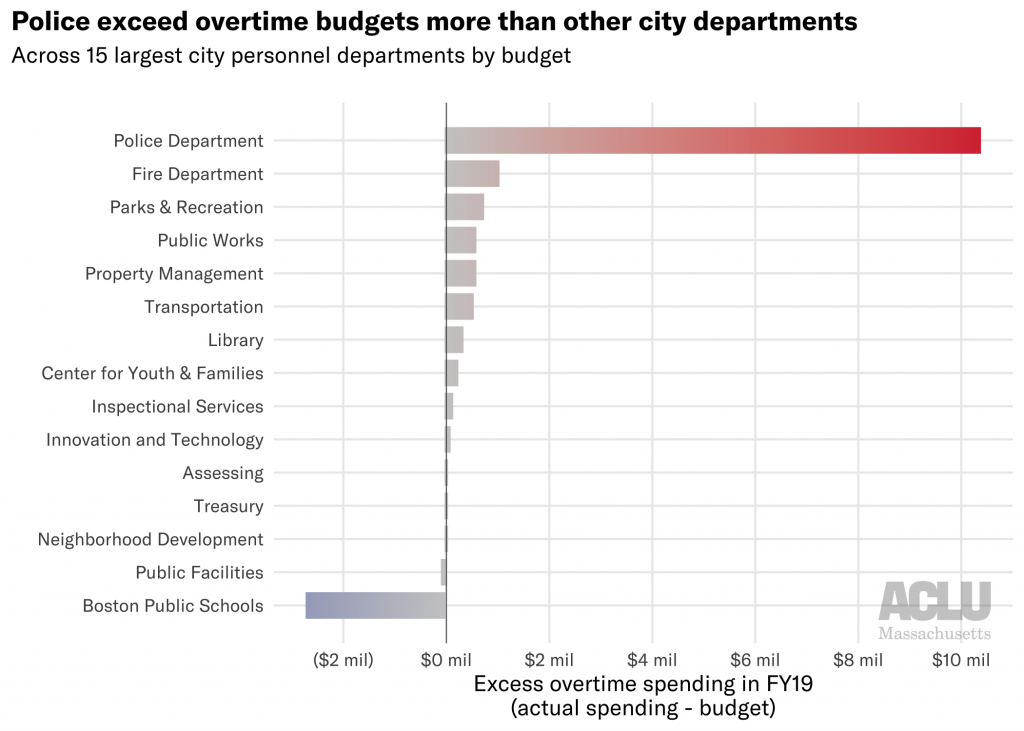
And in comparison, the largest City department, Boston Public Schools, actually spent $2.7 million less on overtime than they were budgeted in FY19.
The City allows police overtime overages to happen because of a vague exception carved out of the City Charter, first included in 1909 and later amended in 1982. It states:
No official of said city, except in case of extreme emergency involving the health or safety of the people or their property, shall expend intentionally in any fiscal year any sum in excess of the appropriations duly made in accordance with law (Boston City Charter, section 42, emphasis added)
In practice this clause is interpreted by the City to mean, as stated by the Boston Municipal Research Board in their 2014 report, that “Police and Fire Department spending for emergency situations, snow removal costs and Execution of Court expenses from court decisions are legally allowed to exceed their appropriations.” No matter that Section 42 does not explicitly mention the Police Department.
Curiously, the above language could suggest that City offices which address public health crises, including COVID-19 and systemic racism, are also allowed to spend in excess of their budgets – but this is not how the Charter has historically been interpreted.
Effectively, the City has decided that all policing qualifies as an “extreme emergency,” and as such is not beholden to budgetary appropriations; police can use City funds with wild abandon without the fear of consequence that other departments face.
What factors contribute to overtime spending?
So where are all of these unfettered overtime funds going? Boston Police officers use various different sorts of overtime:
- Extended tours – when officers work longer than their assigned 8-hour shift
- Additional tours/call out – when officers are called in for unexpected additional shifts
- Court – when BPD officers visit a courthouse (dropping off documents, testifying, etc.) outside of their normal shift; results in a minimum 4 hours of overtime pay regardless of visit length
- Special events –when BPD officers establish a presence at specific events (e.g., parades, sporting events, elections) or certain situations (e.g. heavy police presence at Mass & Cass)
- Replacement – when officers sign up for extras shifts to cover officers who are out on sick leave, vacation, etc.
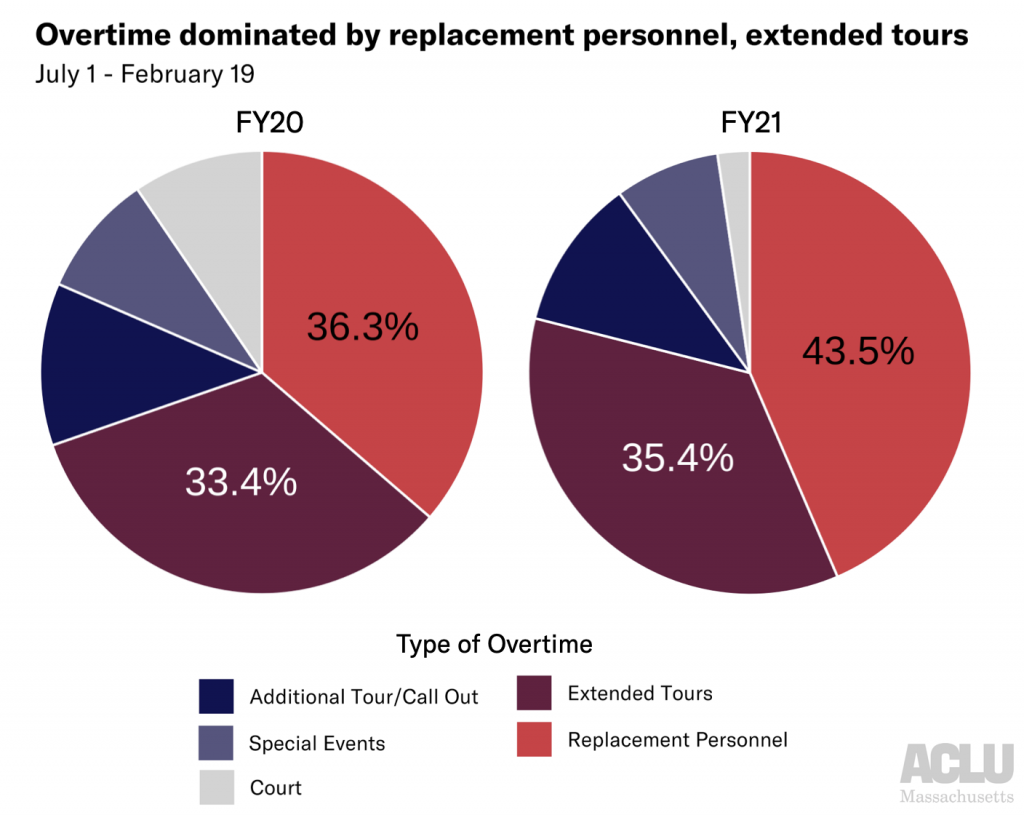
Replacing personnel and extending tours account for the vast majority of overtime hours – over 75 percent so far in FY21. It’s hard to know exactly why this is, as the police have provided multiple reasons including more officers out on sick leave due to COVID, an increase in retirements, and precautions taken around the 2020 election.
But different categories beg the fundamental question: what counts as “overtime”? Why aren’t officers’ schedules arranged such that court visits, annual parades, and longer shifts are included within normal shift scheduling, avoiding costly time-and-a-half overtime pay? Could it be the case that the “minimum staffing” standards that the Department establishes are inflated, requiring more officers than necessary to be on the street, and thus requiring more costly replacement personnel overtime than reasonably required? The BPD has sidestepped questions by the City Council about just these issues.
It's also critical to ask how overtime policing specifically causes harm. Police presence at “special events” has resulted in the cops destroying wheelchairs, running over peaceful protestors (and later bragging about it on camera), and displacing poor and unhoused residents. As long as the City excuses such destructive behavior from the BPD, the cost of police overtime will always be more than just financial.
Careful consideration of such questions helps underscore that the solution to the overtime problem is not hiring more police officers. We aren’t in this overtime mess because Boston has too few cops; we’re in this mess because of toothless budgetary policies, decades of unsupervised policing practices, and an unrestricted power that police wield over their role in the City.
How can we actually fix it?
As the past eight months have exemplified, thanks to the carve-out in the City Charter, any police budget cuts approved by the City Council have no teeth. In addition, many of the policing-related ordinances that the Council is considering this session would be effectively powerless even if passed, because the policies they seek to change are concretized in police union contracts – such as policies defining shift scheduling, discipline, court overtime, 9-1-1 dispatch, and construction details.
Rather than the Council, the governmental body which currently has the power to actualize police budget reform is the Mayor. Specifically, the current budget can be changed based on (1) the Mayor’s priorities while renegotiating police association contracts, and (2) their interpretation of exceptions for police spending written into the City Charter.
We expect that many of the City’s largest police fraternities are now in the process of renegotiating their collective bargaining agreements after their expiration on June 30, 2020, including the Boston Police Patrolmen Association and the Boston Police Detectives Benevolent Society. (There is no way to know the status of new contracts because police association negotiations are not open to the public.) As demonstrated by their statements and actions, police fraternities are neither aligned with the broader labor movement nor are they concerned with public safety; their overreaching power must be reined in.
As such, Boston’s mayor must negotiate contracts that establish reasonable salaries and free up more aspects of policing policy to be under City, not police fraternity, control. Even better, the mayor should lift the veil of secrecy around such an important process: soliciting input from community leaders and advocates when determining priorities and lines in the sand for fraternity contracts, and clearly communicating those priorities to the public. Only then might the City Council pass progressive policing policies that have a shot at actually affecting change.
Additionally, there is reason to believe that of what constitutes an “extreme emergency” as stated in the City Charter might go far to re-establish accountability structures when the police, say, go seven figures over their allocated budget. The police will likely claim that everything they do qualifies as an “emergency,” but the City doesn’t have to agree. Modern policing in Boston includes much more than 9-1-1 dispatch and urgent responses to local events; overtime policing is not emergency response.
Excessive police spending in Boston is a budgetary octopus: there are many different arms thrashing about that contribute to the problem. Between disproportionate payroll increases resulting from extremely powerful police fraternities (i.e. arbitration awards), overly generous court appearance policies that pay police for time they don’t work, monopolization of private construction details, potential misuse of sick leave policies, and costly vacation buyback programs that boost pensions, it can be hard to know where to start.
When it comes to police overtime, the past year has been a long lesson in the danger of symbolic “changes” that ultimately leave the status quo untouched. Yet local advocacy groups like Muslim Justice League and Families for Justice as Healing have not quieted their calls to redistribute police funding back into communities. Their continuing pressure for more transparency has helped to illuminate the path forward.
We know what the next steps are: Acting Mayor Kim Janey, and every mayoral administration to come, must take a strong stance against egregious police spending: refusing to agree to exploitative police union contracts and putting a foot down over “emergency” budget excesses.
Data sources:
- Data on BPD OT usage presented at March 12 Boston City Council hearing
- Documents reporting Boston FY19 departmental OT budgets (listed in FY20 documents) and OT expenditures (listed in FY21 documents)
- Adopted Boston FY21 budget
This report and analysis was authored by Lauren Chambers (ACLUM) with the guidance of Kade Crockford and Rahsaan Hall (ACLUM) . The analysis also benefitted from crucial feedback and input from members of the Muslim Justice League and the Building Up People Not Prisons Coalition.
How to Programmatically Create Dozens of Wordpress Pages to Catalogue Thousands of Documents
This technical blog is cross-posted on Medium.
So you use your Wordpress site to publicly share documents with the world. Maybe they’re photographs in your portfolio, records of minutes from your recurring meetings, homework assignments and materials for your students … or maybe they’re responsive documents from 400 public records requests. You use your site to present these documents in some sort of helpful structure.
And maybe you’ve just acquired, say, 1,400 new documents detailing the use of facial recognition across Massachusetts government agencies, which will require dozens of new structured pages with hundreds of repeated elements to properly display. Manually making all of these new pages with all of these new documents would take approximately infinity hours, and would be absolutely soul-sucking along the way.
But good news: if you’ve got some coding skills, it’s possible to programmatically create all your pages with some setup, some Python, minimal PHP, and the click of a button.
Things you’ll need:
- Wordpress site
- SSH or FTP access to the server hosting your Wordpress site
- Intermediate comfort with Python
- Openness to using basic PHP
- A deep-seated resentment for repetitive tasks
Here’s the process:
- Get your documents in order
- Generate content for (many) Wordpress pages
- Write PHP commands to create (many) Wordpress pages
- Run PHP snippet and publish - once!
The code from steps 2 and 3 is also available in this Jupyter notebook on GitHub.
A quick note before we start: our particular Wordpress setup includes hosting with DigitalOcean, Wordpress editing with Visual Composer, and formatting via the Uncode theme. Some of the code and methods outlined here are particular to these specs.
1. Get your documents in order
First things first, you’ll need to (re)organize your documents before putting them onto the server, so that all of the documents for a single page are siloed in their own directory. This will make it possible to auto-populate the documents and any metadata in each host page later. Depending on how many documents you have and how well organized they are, this step could take a bit.
In our case, we organized the public records requests into different categories, put the documents into different folders for each public records request, and finally split up different documents based on whether they were ACLU messages, government responses, or responsive documents. We used an alphanumeric naming scheme to preserve our intended order, like so:
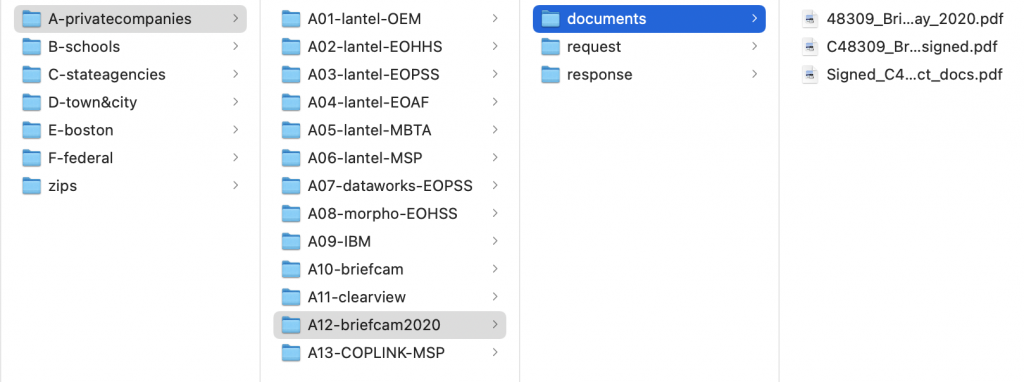
Once you’re done building up your directory structure, you’ll upload these document directories so they can be accessed from your site. Unfortunately, to preserve the structure you’ve just built, you cannot simply add your documents to the media gallery through the normal Wordpress admin interface. Instead, you’ll need to SSH into your server and upload your documents directly using rsync or an application like Filezilla.
(Warning: it took me several hours to upload 3 GB of files to the server with Filezilla!)
You’ll put all of the documents in the appropriate wp-content/uploads folder. For us, that looked something like this (we'll represent placeholders in purple):
- /server/path/to/wordpress/site/public_html/wp-content/uploads/2021/03/A-privatecompanies/A12briefcam2020/…
- /server/path/to/wordpress/site/public_html/wp-content/uploads/2021/03/C-stateagencies/C11-dot-frt/...
and so on.
Once your documents are uploaded, they should already be accessible from your site. Verify this by visiting the URL corresponding to a test file, which should be something like this:
https://homeurl.org/wp-content/uploads/year/month/custom/directories/to/filename.ext
Be sure to encode any parts of this URL that include unsafe URL characters like spaces, hashtags, percent signs, apostrophes, or commas.
With encoding, the document that lives on the server at:
will be available at this URL:
Next, the fun part: programmatically writing your pages.
2. Generate content for (many) Wordpress pages
This step requires creating two components: a spreadsheet which collects certain information for each page you’re publishing, and a Python script which turns that spreadsheet into page content.
For each page, the spreadsheet must include at the very least:
- The path to that page’s document directory (that we just created in step 1) on your local computer
- Any details you’d want to include on the page (e.g., title, date, descriptive text)
Here’s an example of how it might be structured:
| id | Title | Year | Description | Directory Path |
| A12-briefcam2020 | Briefcam at the City of Boston | 2020 | This FOIA request sees no evil | /local/path/to/A-privatecompanies/A12-briefcam2020/ |
| B01-EOPSS | EOPSS Grants for Surveillance Tech in MA Schools | 2019 | This FOIA request hears no evil | /local/path/to/B-schools/B01-EOPSS/ |
| C11-dot-frt | Face Recognition at the Department of Transportation | 2019 | This FOIA request speaks no evil | /local/path/to/C-stateagencies/C11-dot-frt/ |
And now, Python! The basic idea here is to create templates for the parts of your pages that will be the same, and manipulate the information in the spreadsheet to fill in the parts that are unique.
First, you’ll need to create a template for how you’d like your page to be structured: rows and columns, headings, etc. It might include both Wordpress syntax (I use Visual Composer) and raw HTML. Here’s a simple example, a Python string with replacement fields shown in red.
page_template = '''
[vc_row]
[vc_column][vc_column_text]
<h2><span style="color: #000000;">Background</span></h2>
<span style="color: #777777;">
{description}
</span>
<h4>Year:</h4>
<span>{year}</span>
<h4>Documents Returned:</h4>
<span>{n_docs}</span>
[/vc_column_text][/vc_column]
[/vc_row]
[vc_row][vc_column][vc_column_text]
<h2>Responsive Documents</h2>
{docs_table}
[/vc_column_text][/vc_column][/vc_row]
'''
Some of these placeholders - like the description and the year - can be filled in directly from the spreadsheet columns. Others - like the number of documents and the document table - require some further steps.
We can determine the number of documents that will be listed on one page by counting the number of documents within a page’s directory:
import glob
import os
import pandas as pd
# Load spreadsheet with pandas and pull out one row (one page)
all_pages_df = pd.read_excel("db_face_rec_pages.xlsx")
page_metadata = all_pages_df[0]
# Pull out page information from the spreadsheet
description = page_metadata["Description"]
agency = page_metadata["Department"]
category = "Surveillance"
year = page_metadata["Year"]
page_dir = page_metadata["Directory"]
# Count total number of documents
docs = glob.glob(os.path.join(page_dir, "documents", "**"), recursive=True)
n_docs = len([d for d in docs if os.path.isfile(d)])
Writing the raw HTML for the table that will list all documents is a bit more complex. Here, our table will have four columns: a count of files, the file name, type, and size. We iterate through all of the documents inside our page’s directory to fill out docs_table.
import urllib
D4J_root_upload_url = "https://data.aclum.org/wp-content/uploads/2021/02/"
# Create table row (tr) for each document
docs_table = '''
<table><tbody>
<tr>
<td>#</td>
<td>File Name</td>
<td>File Type</td>
<td>File Size</td>
</tr>
'''
doc_filepaths = [d for d in docs if os.path.isfile(d)]
for i, d in enumerate(doc_filepaths):
# Alternate row color
row_color = " background-color: #f2f2f2;" if i%2 == 1 else ""
# Determine the Wordpress URL for each document and encode it
url = D4J_root_upload_url + d.split("dir_for_d4j/")[-1]
url = urllib.parse.quote_plus(url) # encode
# Parse the name and extension from the filename
filename = os.path.basename(d)
title = os.path.splitext(filename)[0]
extension = os.path.splitext(filename)[1].upper()[1:]
# Determine what the file size is (and format in KB/MB/GB)
size_bytes = os.path.getsize(d)
if size_bytes < 1e6:
size = "{:.1f} KB".format(size_bytes / 1e3)
elif size_bytes < 1e9:
size = "{:.1f} MB".format(size_bytes / 1e6)
elif size_bytes >= 1e9:
size = "{:.1f} GB".format(size_bytes / 1e9)
docs_table += '''
<tr style="{row_color}">
<td>{i_doc}</td>
<td>
<a style="color: #006cff;" href="{url}">{title}</a>
</td>
<td>{extension}</td>
<td>{size}</td>
</tr>
'''.format(row_color=row_color, i_doc=i+1, url=url, title=title,
extension=extension, size=size)
docs_table += "</tbody></table>"
With n_docs and docs_table created, we can fill in the main page template:
page_content = page_content_template.format(
description=description, year=year,
n_docs=n_docs,docs_table=docs_table)
Finally, we’ll put all of this into a function, and use pandas’ apply()method to repeat it for every row in the dataframe.
def write_wordpress_page(row):
page_metadata = row
# Pull out metadata and calculate n_docs
....
# Create HTML docs_table for each doc
....
# Combine templates to produce page_content for this page
....
return page_content
all_page_content = all_pages_df.apply(lambda row: write_wordpress_page(row), axis=1)
# Add this page content strings as a column to the original dataframe
all_pages_df["page_content"] = all_page_content
Now we’ve got the page content for all of the pages we want to make. Our next step is to craft the PHP commands that will publish these pages on our Wordpress site.
(For anyone who’s nervous about PHP, worry not: the command we need to do this is extremely simple!)
3. Write PHP commands to create (many) Wordpress pages
To get our page content onto the site, we’re going to use a simple PHP function: wp_insert_post(). This function lets you add a new post or page to your site, and lets you specify not only the content of the post but also the title, publishing mode (public, private, password-protected), parent page, author, and more.
We’re going to use a bit more Python to generate these PHP commands - one for each page we want to use. Again, we’re going to start with a template that we’ll customize:
php_snippet_template = '''
// Add page after wp_loaded
add_action( 'wp_loaded', function () {{
$post_content = "{content}";
$title = "{title}";
$new_page = array(
'post_title' => $title,
'post_name' => strtolower(str_replace(' ', '-', trim( $title ))),
'post_status' => 'publish',
'post_content' => $post_content,
'post_type' => 'page', // Rather than a post
);
// Check to make sure the page doesn’t already exist
$check_page_exist = get_page_by_title( $title, 'OBJECT', 'page');
if(empty($check_page_exist)) {{
$page_id = wp_insert_post( $new_page );
}} else {{
error_log($title . " page already exists; not inserting new post");
}}
}});
'''
We just need to fill in the content and title for each page (again using the handy apply() method from pandas), and then write all of the page-creating commands into one long file (I’m calling it insert_all_pages_php_snippet.txt):
def create_php_snippet(row):
php_snippet = php_snippet_template.format(
content=row["page_content"],
title=row["Title"]
)
return php_snippet
# Generate a snippet for each row (i.e. for each page)
all_snippets = all_pages_df.apply(lambda row: create_php_snippet(row), axis=1)
# Write the snippets to a file
with open("insert_all_pages_php_snippet.txt", "w+") as fo:
for s in all_snippets:
fo.write(s)
Finally, we’re ready to run the PHP on our site and go live with our new pages!
4. Run PHP snippet and publish - once!
I’ve found that the easiest way to run one-time PHP commands on our Wordpress site is with the Code Snippets plugin. This plugin allows you to write, save, and run small chunks of PHP code on your site.
Using Code Snippets, publishing all of the pages is as easy as 1, 2, 3:
- Create a new snippet and select the “Only run once” radio button at the bottom of the code box
- Paste the entire contents of insert_all_pages_php_snippet.txt into the snippet
- Press “Execute Once”

Provided you don’t have any errors in your PHP, that’s that! Ta-da and hallelujah. Let out a deep breath, put on your comfy pants, and grab yourself a beer, because you’re done.
For programmers who want to see how this method was implemented in situ to generate 64 pages housing 1,403 documents on the ACLU of Massachusetts’ facial recognition document repository, checkout our Jupyter notebook on GitHub.
Our notebook also includes examples for how to make more complex pages than detailed here, including:
- Creating pages as children of different parent pages
- Adding buttons on certain pages that link to external sites
- Using HTML to specify custom fonts, colors, and font sizes
- Creating password-protected pages
- Adding custom categories to your generated pages so they’re easier to find
To learn more about the ACLU of Massachusetts’ technical work, explore more around this Data for Justice site: https://data.aclum.org
Clearview, Cameras, and Karen: Newly Released Documents Expose Facial Recognition Technologies Used Across Massachusetts
Today, the ACLU of Massachusetts published a repository of over 1,400 documents which paint a picture of how government agencies across Massachusetts have been using facial recognition technology in recent years. The repository catalogs the breadth of contexts in which the Massachusetts government has flirted with facial recognition, a dystopian technology that is dangerously inaccurate when used on faces with darker skin, feminine features, younger features, or older features.
These documents are the result of over 400 individual public records requests filed predominantly between 2018 and 2020. They chronicle facial recognition surveillance technologies being marketed to and used in state agencies, municipal police departments and schools, and they include hundreds of solicitations from tech companies aggressively marketing their products to a wide range of government agencies.
Explore the Facial Recognition Document RepositoryHere we present highlights from this document repository, namely:
- The widespread and unregulated use of facial recognition scans run by the Massachusetts Registry of Motor Vehicles, on behalf of law enforcement agencies across the country
- An aggressive and, in some cases, successful law enforcement marketing campaign by dystopian surveillance startup Clearview AI
- Multiple instances of smaller companies partnering with government agencies to deploy dangerous surveillance technologies without public knowledge
Great Power Without Responsibility: Facial Recognition at the RMV
The largest and most comprehensive state or local government facial recognition program in Massachusetts is managed by the Registry of Motor Vehicles (RMV). This system was put in place in 2006 with the original goal of investigating fraud in the licensing process. Almost immediately after obtaining its facial recognition system fifteen years ago, the RMV told policing entities throughout the state that they could send photos of unknown persons to be searched against its statewide license and identification photo database.
Documents obtained by the ACLU of Massachusetts through a public records lawsuit show that the RMV ran hundreds of scans for police each year, and not just for Massachusetts entities. ICE, the DEA, the Department of Homeland Security, and NYPD all requested scans between 2016 and 2018.
The records show the RMV performed these searches absent any state law or regulations to govern their use, and without any judicial oversight or internal mechanisms to prevent abuse. In order to request a scan, law enforcement and immigration authorities simply sent emails claiming to be from law enforcement, with no verification required. Searches were recorded in written logs only, apparently in red colored pencil, and with spurious reporting standards: over 70 scans were run in 2016 and 2017 on behalf of an employee listed simply as “Karen.” Multiple emails describe scans that were run using photos taken from personal Facebook profiles. According to the records, the RMV did not decline a single search request from any law enforcement official during the time period covered by the records request.
During that period, the RMV facial recognition system was used by a wide range of parties. In Massachusetts, while the Boston and Cambridge Police Departments each submitted dozens of requests, over 30 other departments submitted one or more.

Many officers from out-of-state successfully requested searches, including the South Carolina DMV, the New Hampshire State Police, Rhode Island Police, and the NYPD. Federal agencies took advantage, too: requests appear in the logs from Customs and Border Patrol, the Department of Homeland Security, ICE, the Secret Service, and the IRS.

What was the reasoning behind these scans; were they tied to violent crime investigations, petty theft, immigration, or just an officer curious to dig up dirt on an ex? Did the RMV take steps to mitigate the known racial bias of the software? The RMV’s handwritten logs provide no context. Given that the RMV facial recognition system contains a photo of every individual with a Massachusetts driver’s license or state identification card, these regulatory failures are particularly irresponsible and dangerous.
Dystopia, Get Your Dystopia Here: Clearview’s Marketing Tactics
In 2019, national news stories broke about a terrifying new technology company that links facial recognition results to other content on the internet. With a single facial image, Clearview AI claims it can identify an individual’s photos that are linked to Facebook, Twitter, Flickr, YouTube, and more. Clearview pulls off this freaky feat by scraping billions of images from social media sites— despite being told to cease and desist by multiple companies.
A leak of Clearview’s data in early 2020 revealed widespread use of Clearview by over 2,000 police departments nationally, as well as numerous foreign governments and private companies. Concerned about its adoption in Massachusetts, the ACLU of Massachusetts filed public records requests with every police department in the Commonwealth - 346 in total - to obtain emails mentioning Clearview.
These emails show the company successfully gaining a foothold among Massachusetts law enforcement. At least eight law enforcement agencies statewide accepted Clearview’s invitation to start a free trial of their software: Agawam PD, Marlborough PD, Somerset PD, Wellesley PD, Yarmouth PD, Falmouth PD, Norfolk County Sheriff’s Office, and Oxford PD. In Somerset, the police department originally denied in writing using Clearview until data was leaked revealing one detective had indeed been using a free trial, possibly without the knowledge of department superiors—let alone residents or local elected officials. The detective even used Clearview to run a scan on behalf of an NYPD officer. Such stories demonstrate that in the absence of community control of police surveillance, police and private companies often work together in the shadows to dangerously expand police surveillance tactics.
Records also show an aggressive marketing scheme towards PDs that ultimately didn’t bite: at least 36 Massachusetts police departments received solicitations from Clearview - and probably many more, given that not all record requests were answered. These solicitations were sometimes sent directly from Clearview, but more frequently were sent by publications such as American Police Beat Magazine, Officer.com, or Police Magazine– an indicator of the chilling extent to which facial recognition is marketed to the police. Clearview’s own marketing encourages its users to “take a selfie” or run a search on a celebrity’s photo - behavior that would most likely be barred if the use of the technology were subjected to any sensible rules, regulations, or laws.
Here, There, Everywhere: Facial Recognition Throughout Government
Unfortunately, Clearview and the RMV are just the tip of the iceberg when it comes to government use of facial recognition in Massachusetts. From records requests filed with government offices in over 40 Massachusetts cities and towns, multiple cases arose of small companies peddling dangerous technologies for government use.
In the Town of Plymouth, for example, emails from 2018 reveal extensive communication between the chief of police and Jacob Sniff, the young founder of a billionaire-backed facial recognition startup called Suspect Technologies. At one point during discussion about the Plymouth PD adopting his software, Sniff admits that his product might work just “30% of the time” on poorer-quality images such as those taken from surveillance camera footage. Showing a baffling degree of hubris, Sniff also asks the police department to help him get access to the RMV database - a government system containing personally identifiable information for over 5 million Massachusetts residents. After the ACLU disclosed these emails to the press, the Plymouth Police Department said it would not contract with the company. But these emails show how profit-hungry companies are quietly pressuring even small police departments to buy into unreliable dystopian technologies, and that absent strong law to protect people’s rights and the public interest, police are all too often eager to sign up.
In Revere, we learned that the public school system uses a visitor management software called LobbyGuard that claims to “screen and track everyone who enters your schools.” Though the school district asserts that LobbyGuard does not use facial recognition, the use of such a technology raises concerning questions about privacy and surveillance in school settings, the transfer of sensitive data to little-known corporations, and the role of private companies in expanding government surveillance.
And in the City of Boston, a looming software update from a video analytics company called Briefcam threatened to supercharge all of the region’s networked surveillance cameras with face surveillance software with just the click of a button. Documents from 2019 show that the City upgraded their Briefcam video analytics software to version 4.3. Just a year earlier, Briefcam had launched a new facial recognition feature – in version 5.3. All the City had to do was install a single software update, and the faces of hundreds of thousands of Boston residents and visitors would have begun to be systematically cataloged. Thankfully, a facial recognition ban backed by the ACLU, the Student Immigrant Movement, and many other organizations unanimously passed by the Boston City Council in June makes any such software update illegal in the City of Boston.
What’s perhaps most frightening about these documents is the pattern they suggest: it’s clear that this predatory and biased technology has found fertile ground to take root among Massachusetts government agencies. At least ten municipal police departments have embraced facial recognition technologies provided by unregulated third-party private vendors. And if officers aren’t wary of starting a free trial with Clearview, and police chiefs feel comfortable negotiating contracts with fledgling companies like Suspect Technologies, where would they draw the line?
Without law preventing it, more software trials will be started, more contracts will be signed, and more Massachusetts residents will be endangered. We don’t have to speculate – multiple cases of Black men being wrongfully arrested on the basis of faulty facial recognition scans warn of how this story might end.
These documents further underscore the importance of a newly proposed bill that would impose strict limitations on the use of face surveillance by Massachusetts government agencies. While the state police reform bill that was passed in December 2020 includes some regulations on police use of facial recognition, the newly proposed bill goes much further, prohibiting the vast majority of government agencies from obtaining or possessing the technology and thus protecting Massachusetts residents from aggressive marketing campaigns waged by companies like Clearview and Suspect Technologies. The bill would also enforce a higher standard on police use of facial recognition, requiring a warrant, limiting the technology’s use to serious investigations, establishing key due process protections, and establishing a supervised, centralized process for all facial recognition searches.
We must enact strong and unambiguous law to govern facial recognition technology - because as these documents show, we cannot trust law enforcement and private companies to regulate themselves.
If you’re interested to learn more about how facial recognition might affect your community, we invite you to visit the Press Pause on Face Surveillance homepage, and explore the document repository on the ACLU of Massachusetts’ Data for Justice Site:
Explore the Facial Recognition Document RepositoryData Show COVID-19 Out of Control Across Massachusetts Prisons and Jails
Four county facilities with over 80 confirmed COVID-19 cases. Multiple county jails conducting fewer than 100 COVID tests over nine months. A 10 percent increase in individuals jailed before trial across the state.
Yesterday, together with the Committee for Public Counsel Services (CPCS) and the Massachusetts Association of Criminal Defense Lawyers (MACDL), the ACLU of Massachusetts filed an amended petition in their existing case with the Supreme Judicial Court seeking relief for individuals incarcerated in county facilities who are currently threatened by the spread of COVID-19 across the state.
Almost nine months have passed since ACLUM first filed this lawsuit in late March, asking the Court to recognize the elevated risk that the pandemic posed to individuals incarcerated in both county and state facilities and to decrease the population of carceral facilities across the state. The Court’s ruling recognized the necessity of decreasing the incarcerated population, and ordered jails and prisons throughout the state to regularly report their population, releases, COVID-19 tests and results.
While yesterday’s filing focuses solely on county facilities, the data reported by both county and state facilities since April raise significant concerns regarding COVID-19 in carceral settings throughout the state.
An interactive dashboard created and maintained by the ACLU of Massachusetts presents weekly data reported by 19 facilities run by 13 county sheriffs (jails and houses of correction or HOCs) and daily data from 16 state Department of Correction (DOC) prisons – 35 facilities in sum. Analysis from the first week of reporting in April already demonstrated an inadequate COVID response in prisons and jails that, unfortunately, has continued for the better part of a year. Indeed, in recent weeks, advocates, attorneys, and worried family members have witnessed frighteningly low test rates, followed by outbreaks in over a dozen facilities – and now, deaths. Here we present four takeaways from recent trends.
1. A battle against multiple simultaneous outbreaks
Since outbreaks of COVID-19 began increasing in Massachusetts in September, 27 prisons and jails statewide have seen more than 5 prisoners or staff infected with COVID-19. Seven facilities have seen more than 100 positive tests, and four facilities saw more than 100 simultaneous cases in a single outbreak.

In some state prisons, vast swaths of the facility’s prisoner population were (or are) infected at the peak of the outbreak, including: 33 percent of MCI-Concord (1 in 3) on December 7, 15 percent of MCI-Shirley on November 30, and 14 percent of MCI-Norfolk (1 in 6) on November 12.
| Facility Name | Positive tests (staff & prisoners), cumulative since Sept. 1 | Maximum active prisoner cases at peak of outbreak | Maximum active staff cases at peak of outbreak† |
| Barnstable County Correctional Facility | 10 | 0 | 9* |
| Bristol County Jail and House of Correction | 25 | 5 | 13* |
| Essex Middleton House of Correction | 257 | 137* | Not reported |
| Hampden County Correctional Center | 233 | 87 | 30* |
| Middlesex Jail & House of Correction | 46 | 9 | 26* |
| Plymouth County Correctional Facility | 123 | 43 | 35 |
| Suffolk South Bay House of Correction | 84 | 19 | 11 |
| Suffolk Nashua Street Jail | 41 | 17* | 8* |
| [DOC] Massachusetts Alcohol and Substance Abuse Center | 65 | 25 | Not reported |
| [DOC] MCI-Concord | 356 | 172 | Not reported |
| [DOC] MCI-Norfolk | 498 | 178 | Not reported |
| [DOC] MCI-Shirley | 337 | 167* | Not reported |
| [DOC] Massachusetts Treatment Center | 49 | 26* | Not reported |
| [DOC] North Central Correctional Institution | 228 | 83* | Not reported |
* - active positive cases stagnant or increasing as of December 22
† - no DOC facilities report active staff cases
The bottom line is that COVID-19 is raging across our jails and prisons, and the existing response is clearly proving inadequate.
2. Testing has been consistently abysmal
There is a major and concerning caveat to available data on outbreaks: the numbers described above are just those COVID-19 cases that were confirmed via testing. Many prisons and jails are still not testing at a sufficient rate to detect and contain cases, and so there is reason to believe even the extreme outbreaks we’ve seen are underestimates.
Indeed, eight counties have not even conducted enough testing to account for their entire population once since outbreaks began accelerating in September. The most egregious examples include Barnstable County, which has conducted just 4 COVID tests since September while their prisoner population never dipped below 170and Worcester County, which has conducted just 39 COVID tests since September while their prisoner population never dipped below 566.
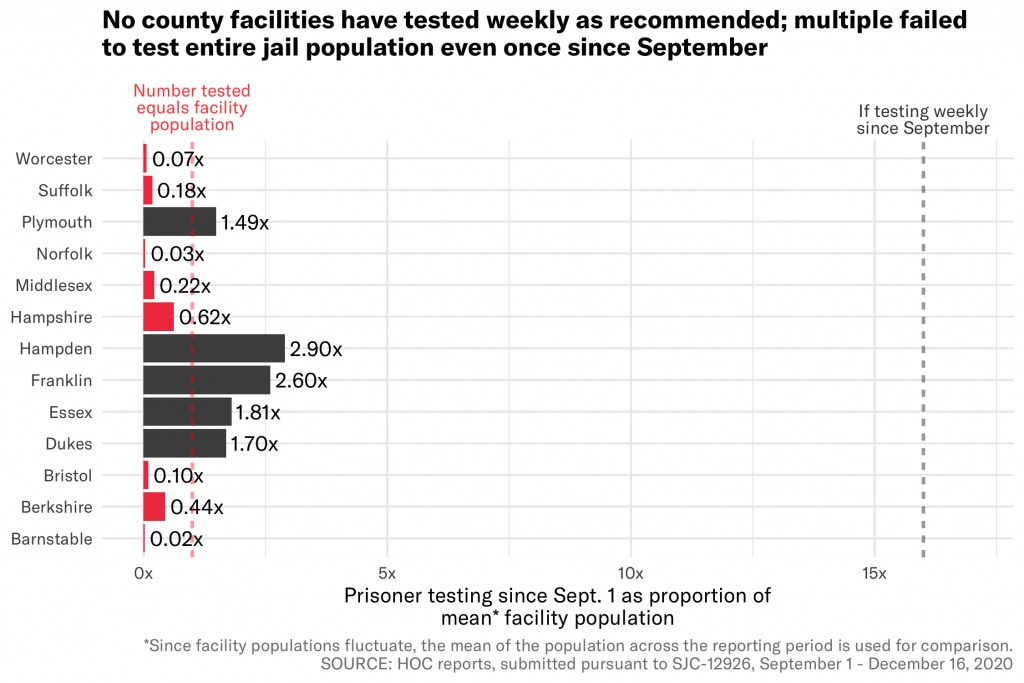
For comparison, Tufts University – which has a similar student population to the statewide prisoner population – has conducted almost as many tests in the previous 7 days (13,104) as all 13 county facilities have in the past nine months (13,562). And since August, Tufts has conducted more than 7 times as many tests (256,156) as all Massachusetts prisons and jails have since April (35,157).
And it’s not just private universities that are blowing jails out of the water; a state policy defined in June requires all staff at long-term care facilities to be tested weekly. The most recent state report showed that 407 of the 427 long-term care facilities in the state (95 percent) are currently compliant with this policy, as of the week of December 3-10.
The abysmal level of testing in jails is simply unacceptable, and they leave government officials effectively clueless as to whether new outbreaks are taking root across their facilities.
3. Rising prisoner populations increase danger
Yet testing is not the only preventative measure that prisons and jails have at their disposal, nor is it the only response that they are failing to properly implement.
One of the most effective measures to curb the spread of COVID is to reduce the population of incarcerated people – fewer people in cramped quarters reduces spread and saves lives. But concerningly, recent data show that many facilities are actually increasing their populations now, after a drop in the spring. And the population of those being held pretrial – people who have not been sentenced with a crime but are currently incarcerated – is actually higher today than it was at the start of reporting in April. Over 400 more people are currently incarcerated pretrial than nine months ago: 4,355 on December 16 compared to 3,928 on April 5.
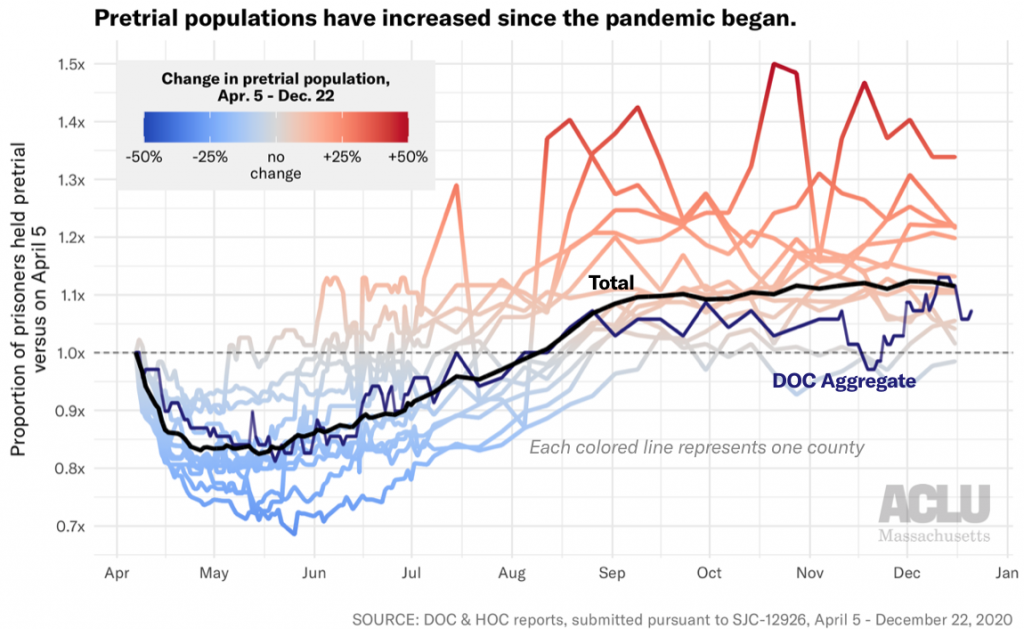
Franklin County saw the largest proportional increase with a 34 percent jump in pretrial prisoners since April – from 62 to 83. In larger facilities, the raw difference is even more stark: Hampden County has 106 more prisoners held pretrial today than in April (+22 percent), Bristol County has 86 more (+20 percent), Essex County has 84 more (+13 percent) and Suffolk County has 75 more (+11 percent). And across all DOC facilities, we also see a 7 percent increase in pretrial prisoners, from 69 to 74.
Overall, while the statewide incarcerated population fell by over 2,000 in the first few months of the pandemic, the population has risen by 300 since the lowest point in late June. Rather than further stuffing already crowded carceral facilities, Massachusetts should instead be following in the footsteps of states like Colorado, which has reduced their jail population by 46 percent during the pandemic.
One available tool for decarceration is to release those prisoners who are statutorily eligible to home confinement. Recent analysis by CPCS estimates that approximately 427 prisoners held in county facilities as of December 11, 2020 were eligible for home confinement programs. However, three of the 13 counties do not even have a home confinement program, and those that do have such programs not used them to meaningfully reduce their populations. Indeed, as of November 5, 2020, a total of just 16 individuals were on home confinement from a county facility. Similarly, while the DOC has a home confinement program, available data show it has made no placements since at least .
Prisons and jails need to use every tool in their toolbox to protect those in their care, and decarceration is one of the most effective tools. Massachusetts must drastically step up its prisoner releases and decarceration efforts immediately.
4. The consequences of inaction are fatal
Of course, these data on cases and positives represent human lives.
The DOC recently reported that a prisoner at MCI-Norfolk died from COVID-19 complications in their custody on December 4th. Two prisoner deaths were subsequently reported on December 14th, at MCI-Concord and MCI-Shirley. These reports come after the state saw no deaths for five months through the summer.

Furthermore, a shocking WBUR story in early December revealed that in at least two cases, the DOC approved medical parole for prisoners less than 24 hours before their death. Because these individuals were no longer technically in DOC custody, their deaths were not included in DOC reports to the petitioners.
One of these deaths was Milton Rice, a 76-year-old prisoner who had applied for medical parole in March, stating, "with my underlying health condition and compromised immune system issues, should I contract the COVID-19 virus it would more than likely be fatal for me." He was finally granted medical parole on November 24, two weeks after testing positive, and he died of COVID-19 pneumonia on November 25 – the day before Thanksgiving.
As counsel in the SJC case wrote on March 24th, "There are about 16,500 human beings in our prisons and jails. None of them have been sentenced to death. Yet, without aggressive and immediate intervention, COVID-19 will likely kill many of them." We have seen at least 13 deaths since then, with no appropriate response in sight.
The numbers presented here describe only the tip of an iceberg of an inadequate COVID-19 response. In a federal filing last month, Plymouth County Correctional Facility stated that asymptomatic staff at their facility were “not required to quarantine following an exposure to COVID-19.” One such staff member who returned to work tested positive less than a week later. Plymouth has since indicated that it has “resumed quarantining all close contacts and will only reduce the quarantine period in the future as required to maintain the safety and security of inmates and detainees.” Lockdowns, restrictions on visitation, and the use of solitary confinement as quarantine have been widely implemented – to the detriment of prisoners’ mental health over the past nine months. And throughout the pandemic, there have been reports from inside facilities of staff not consistently wearing masks or PPE.
Two weeks ago, Governor Baker’s office announced that Massachusetts will become one of the few states to include incarcerated individuals in Phase One of the statewide COVID vaccination plan. While this is an important and necessary measure for the future, it does not absolve the government of its responsibility to protect prisoners today; major changes are necessary to ensure that prisoners stay alive long enough to receive a vaccine. And for many, the vaccine will be too little and too late to right the wrongs affected by harmful policies over the past nine months. We know of at least 2,500 Massachusetts prisoners who have already been infected with this disease, and the consequences for their families and communities will be long-lasting.
Also two weeks ago, Governor Baker vetoed line item 8900-0001 from the proposed FY21 budget, which would create an independent ombudsman office to monitor COVID-19 in prisons:
https://twitter.com/justicehealing/status/1337499657069621250
The proposed office was a hard-fought victory by advocacy groups such as Families for Justice as Healing (FJAH), and already represented a legislative compromise. Unfortunately, this veto is just further evidence of the state’s failure to take sufficient action to protect those in their custody in the midst of this pandemic.
State and county governments in Massachusetts must take responsibility for the humanitarian crisis currently threatening – and killing – those in their care. They must drastically increase testing and both pretrial and post-conviction releases immediately, and provide more transparency on how vaccines will be distributed inside prisons and jails.
Take action:
- Use the Building Up People Not Prisons Coalition’s toolkit to contact your state legislators and urge them to override Baker’s veto of the correctional oversight office
- Use FJAH’s toolkit to contact the Department of Public Health commissioner and Department of Correction commissioner, urging them to reduce prison and jail populations and systematize COVID-19 testing
Break Up with the BRIC: Unpacking the Boston Regional Intelligence Center Budget
Explore all of the ACLU of Massachusetts' analysis on policing in the Commonwealth.
On Thursday, July 23, the Boston City Council is holding a hearing on three grants that would collectively approve over $1 million in additional funding to the Boston Police. These taxpayer dollars would go towards installing new surveillance cameras across Boston and funds for the Boston Regional Intelligence Center, or BRIC.
Thursday’s hearing is a re-run from a routine hearing which took place on June 4, in which the Boston City Council was slated to rubber-stamp these three grants - dockets #0408, #0710, and #0831. However, community advocate groups such as the Muslim Justice League rallied, urging the Councilors to be critical of – and ultimately reject – the BPD grants. Ironically, the BRIC representative failed to make an appearance at the hearing and the question of the grant approval was tabled for this future date.
Out-of-control funding of the Boston Police is nothing new - as discussed in an ACLU of Massachusetts analysis, in FY21 the initially proposed Boston Police budget was $414 million. Ultimately, the Boston City Council still approved $402 million for the BPD, despite thousands of constituents advocating for more substantial budget cuts.
However, specific scrutiny of the BRIC and its funding is long overdue. In recent years, city, state, and federal legislatures have authorized well over $7 million in funding for the BRIC each year. But due to BPD secrecy surrounding all things BRIC-related, it’s hard to paint a full picture of what the BRIC does with this funding. Indeed, the description of the program on the Boston Police Department website consists of a mere 122 words - so we are forced to consult alternate sources and public records requests to get any details.
A new analysis of public records by the ACLU of Massachusetts takes a closer look at where the BRIC’s money comes from -- and what it’s used for.
What is the BRIC?
The Commonwealth of Massachusetts is home to two federal fusion centers: Department of Homeland Security-funded centers established after September 11th, which facilitate information sharing between local, federal, and state law enforcement. One such center, the Commonwealth Fusion Center, is operated by the Massachusetts State Police, while the second, the Boston Regional Intelligence Center, or BRIC, is operated by the Boston Police Department.
The BRIC operates across the entire Metro Boston Homeland Security Region (MBHSR), which includes Boston, Brookline, Cambridge, Chelsea, Everett, Quincy, Revere, Somerville, and Winthrop.
Ample and Diverse Funding
According to public records obtained and compiled by the ACLU of Massachusetts, the BRIC is funded by a combination of federal, state, and local budgets and grants.
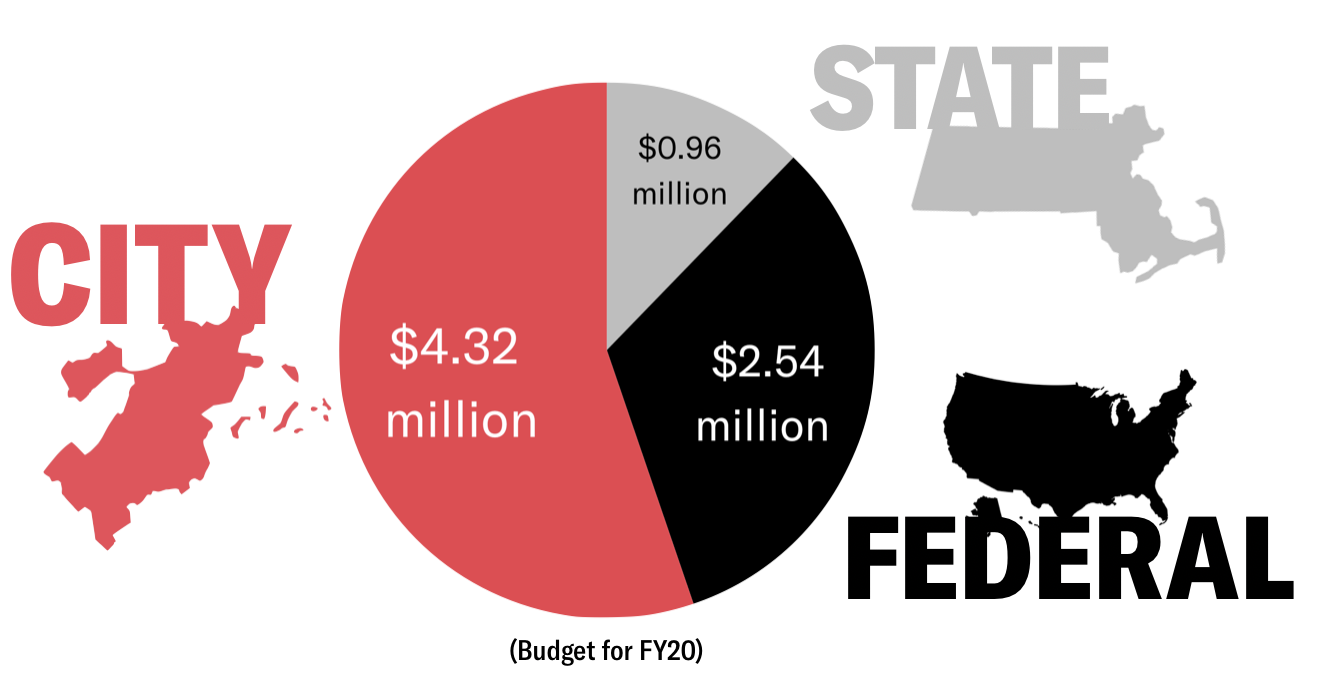
Specifically, the BRIC receives funding from at least four distinct sources:
- Department of Homeland Security (DHS) Federal Emergency Management Agency (FEMA) Urban Areas Security Initiative (UASI) grants
- Massachusetts Executive Office of Public Safety and Security (EOPSS) yearly allocations, most likely from the DHS FEMA State Homeland Security Grant program
- Massachusetts state budgets (passed through the Executive Office of Public Safety and Security (EOPSS); line item 8000-1001)
- City of Boston operating budgets (via the Boston Police Department’s Bureau of Intelligence & Analysis)

These four funding streams combined lead to the BRIC receiving approximately $7-8 million each year in public funds.
Note that correspondence with the City of Boston revealed that publicly available data for the FY19 BPD Bureau of Intelligence & Analysis budget is incorrect due to a “posting error”, and so FY19 is excluded from all figures.
Additionally, it’s important to note that due to the lack of transparency, these four sources might not encompass all of the funding coming into the BRIC. For instance, a FY21 report of BPD contracts shows $4 million in payments for “intelligence analysts” to Centra Technologies between 2018 and 2021, likely working at the BRIC. If so, the BRIC budget may indeed be millions of dollars greater than what we are able to report today.
Who’s on the payroll?
How many people do work for the BRIC – and get their salaries from its budgeted funds? Ten? Sixty? It’s difficult to know.
Expense reports reveal at least 41 employees received training from the BRIC between 2017 and 2019 - but 10 of these names do not appear on the City of Boston payroll for those years.
Records show that the BRIC has some dedicated employees: in FY20, the personnel budget for the BPD’s Bureau of Intelligence and Analysis - whose sole charge seems to be the management of the BRIC - was $4.3 million. And in 2019, BRIC expense reports show $1.8 million in payments towards contracted “Intelligence Analysts” through companies such as Centra Technology, The Computer Merchant, and Computer and Engineering Services, Inc. (now Trillium Technical). But would this $1.8 million support 7 analysts making $250k per year? 30 analysts at $60k? The records do not provide clarity on this point.
Finally, confusion around one of the grants being discussed at Thursday’s hearing, proposed in docket #0408, further epitomizes the BRIC’s financial obfuscation around its payroll. The docket formally proposes $850,000 in grant funding to go towards “technology and protocols.” However in discussion at the June 4 hearing it was revealed that, in actuality, part of the grant would go toward hiring 6 new analysts.
By keeping under wraps the roles and job titles of BRIC employees, and even simply the size of the Center, BRIC obstructs transparency, public accountability, and city council oversight.
Hardware and Software Galore
Between 2017 and 2020, BRIC expense reports show the Center spent almost $1.3 million on hardware and software. Thorough review of these reports reveals exorbitant spending: on software of all flavors, scary surveillance technologies, frivolous tech gadgets, and some obscure mysteries.
A number of the expenses are clearly for surveillance cameras and devices, including $106,700 in orders for “single pole concealment cameras”. These pole cameras were bought from Kel-Tech Tactical Concealments, LLC, a company which also supplied the BRIC with some truly dystopian concealment devices such as a “Cable splice boot concealment” ($10,900), a “ShopVac camera system” ($5,250), and a “Tissue box concealment” ($4,900). These purchases imply the BRIC is hiding cameras in tissue boxes, vacuum cleaners, and even electrical cables.
Some of the charges on the report are just too vague to interpret. This includes the largest hardware/software charge in the entire report: $164,199 paid to Carousel Industries for “BRIV A/V Upgrade per Bid Event”. There’s $36,997 in “Engineering Support”, paid to PJ Systems Inc. and $15,606 in a “C45529 CI Technologies Contrac[t]”, paid to CI Technologies. And concerningly, there is a cumulative $16,200 in charges described simply as “(1 Year) of Unlimited” paid to CovertTrack Group Inc. – a company which also supplied the BRIC with a “Stealth 4 Basic Tracking Devic[e]” to the tune of $7,054.
When it comes to computing hardware, there’s no skimping either. Reports show over $200,000 in expenses for servers, and over $67,000 for various laptops. And apparently the BRIC prefers Apple products - judging by the $10,000 they spent on iPad pros, almost $1,000 on Apple Pencils, and $367 on Apple TVs.
Yet the most indulgent spending is on software. Between 2017 and 2020, the BRIC purchased at least 13 specialized software products for intelligence analysis, crime tracking, public records access, device extraction, and more.
| Software | Use | BRIC Expenses 2017-2020 |
| IBM i2 | “Insight analysis” | $124,852 |
| CrimeView Dashboard | Crime analysis, mapping and reporting | $58,009 |
| Accurint | Public records searches | $32,803 |
| Esri Enterprise | Geospatial analysis | $27,000 |
| Thomson Reuters’ CLEAR | Public records searches | $25,322 |
| CrimNtel GIS | Crime analysis, mapping and reporting | $21,016 |
| Computer-Aided Dispatch (CAD) Interface | Emergency response | $16,387 |
| Cellebrite Universal Forensic Extraction Device (UFED) Ultimate 4PC | Device data extraction | $12,878 |
| CaseInfo | Case management | $10,508 |
| NearMap | Geospatial analysis | $9,995 |
| ViewCommander-NVR | Surveillance camera recording | $3,778 |
| eSpatial | Geospatial analysis | $3,650 |
| XRY Logical & Physical | Device data extraction | $2,981 |
And worse, there is redundancy between the products - the BRIC purchased three different geospatial analysis products, two public records search products, and two device data extraction products.
This smorgasbord of tools begs the question: What, if any, supervisory procedures exist within the BRIC to prevent irresponsible spending of taxpayer dollars on expensive, duplicative software?
And furthermore, some of these public records databases give users immense power to access residential, financial, communication, and familial data about almost any person in the country. So who, if anyone, oversees the use of powerful surveillance databases like Accurint and CLEAR, to ensure they aren’t being used to violate basic rights and spy on ex-girlfriends?
From a history of First Amendment violations in Boston, to their role in threatening local immigrant students with deportation, to a 2012 bipartisan Congressional report concluding fusion centers such as the BRIC have been unilaterally ineffective at preventing terrorism, there is much evidence in support of the BRIC being wholly defunded. But at the very least, the Boston City Council must end the practice of writing blank checks for the Boston Police to continue excessive and unscrutinized spending of taxpayer dollars.
The Boston City Council must reject the additional $1 million in funding to the Boston Police being proposed in these three grants. To learn more about the BRIC, the proposed grants, and to urge the City Council to reject them, we encourage you to:
- Consult the Muslim Justice League Toolkit to Get the BRIC Out of Boston
- Sign a petition telling Boston City Councilors to reject BRIC-related grants before Tuesday, July 28
- Submit written testimony for the BRIC budget hearing before 9:30 AM on Saturday, July 25, telling Boston City Councilors to reject BRIC-related grants
Bond Bill Funds Prisons and Police over Education
Editor's Note: Today, the Senate Bonding Committee gave S2579: the General Government Bond Bill (previously H.4733) a favorable report. Last week, the committee on Senate Bonding, Capital Expenditures and State Assets concluded hearings on this bill. We are glad to see that the committee added limiting language to ensure that the $150 million authorization for public safety facilities would not be spent on building new prisons or jails. As the bill advances to Senate Ways and Means, we hope to see more amendments that prioritize investment in communities rather than policing and prisons.
What is the “General Government Bond Bill” and why should we care?
Last week the committee on Senate Bonding, Capital Expenditures and State Assets concluded hearings on H.4733, the General Government Bond Bill (originally H.4708). This Bond Bill intends to finance general governmental infrastructure of the Commonwealth around “public safety, information technology and data and cyber-security improvements.”
Bond bills are borrowing bills which pass on not just debt to future generations but also values. Given the huge disparities the pandemic has both exposed and created through mandatory remote learning, the top priority for any debt for future taxpayers should in fact be their current education. The COVID-19 pandemic has shown how crucial basic broadband infrastructure is to ensure equitable access to education. Education Commissioner Jeff Riley testified last month to the need of $50 million to support MA school districts to reach students without internet access (9% of students) or exclusive use of a device (15% of students).
Instead, this bill allows for at least $270 million to build prisons, acquire police cruisers and other equipment for the Department of Corrections. The events of the last few weeks have shown the unnecessary, unwise, and unjust investment in the criminal legal system -- a system that over-polices, over-prosecutes, and over-incarcerates Black and Brown communities in the Commonwealth. The bill’s funding priorities need to be flipped.
As the Boston advocacy organization Families for Justice as Healing states in their call to action against H.4733, "The Commonwealth already spends more money per capita on law enforcement and incarceration than almost any other state. Communities need capital money for critical infrastructure projects like housing, carte facilities, parks, schools, treatment centers, healing centers, community centers, and spaces for art, sports, and culture."
Why are we still investing in police and prisons?
Over the last week, the world has watched as protests against police brutality and unaccountability have been met with further use of excessive force on protestors. As we live through the historic Black Lives Matter movement, the ACLU of Massachusetts (ACLUM) has joined the calls of Black and Brown-led organizations to divest from police in favor of investments in systems that support, feed, and protect people.
There have been demands from across the country to defund police departments, with the Minnesota City Council declaring its intent to disband the police department all together. The timing of further funding of police departments is incomprehensible at this watershed moment for racial justice across the country and in the midst of an economic freefall due to the COVID-19 pandemic.
Bond bill H.4733 does not meet this moment. In testimony to the Senate Committee on the Bond Bill, ACLUM strongly opposed line item 8000-2025, which would authorize an enormous amount of borrowing to build prisons. Families for Justice as Healing also opposed this line item, testifying that "significant decarceration is possible and further decarceration is doable and practical under current law, and at a cost-savings to the commonwealth."
ACLUM also opposed line item 8000-0703, authorizing the borrowing of $30 million for the purchase of Department of Corrections and Executive Office of Public Safety and Security for equipment and vehicles, and line item 8000-2024, authorizing the borrowing of $92 million for the purchase of police cruisers. (This is enough to put over $40,000 towards a new or improved car for all 2,199 Massachusetts State Police employees.)
Even without bond funds, police departments across the Commonwealth and the country are incredibly well funded. As previous ACLUM analysis of the City of Boston budget on Data for Justice shows, compared to the budgets of other Boston City departments (and cabinets), the Boston Police budget is exponentially higher than that of community focused organizations like Library, Neighborhood Development and Office of Arts and Culture.
Why aren’t we investing in actual information technology infrastructure?
Instead of authorizing new debt to build prisons and increase police budgets, we should be investing in information technology to support educational equity throughout the Commonwealth. In that way, this bond bill could truly reflect values we want to pass down to our children.
At present, the line item 1599-7064 is the only one which directly does this, authorizing $40 million to help close the digital divide for students in the Commonwealth. Certain emergency measures have been taken by school districts to enable transition to remote learning such as tablets and free access to assistive technology. However a bill that is intended to finance the general governmental infrastructure of the Commonwealth, and in particular to provide assistance to public school districts for remote learning environments, should invest in more than $40 million in state-wide digital infrastructure to permanently close the digital divide.
What exactly do we need to invest in?
Data from the United States Census American Community Survey show that about 8% of households either do not have a computer, or if they do, do not have access to the internet at all. Furthermore, more than 1 million Massachusetts residents (> 15%) do not have a fixed broadband internet connection.
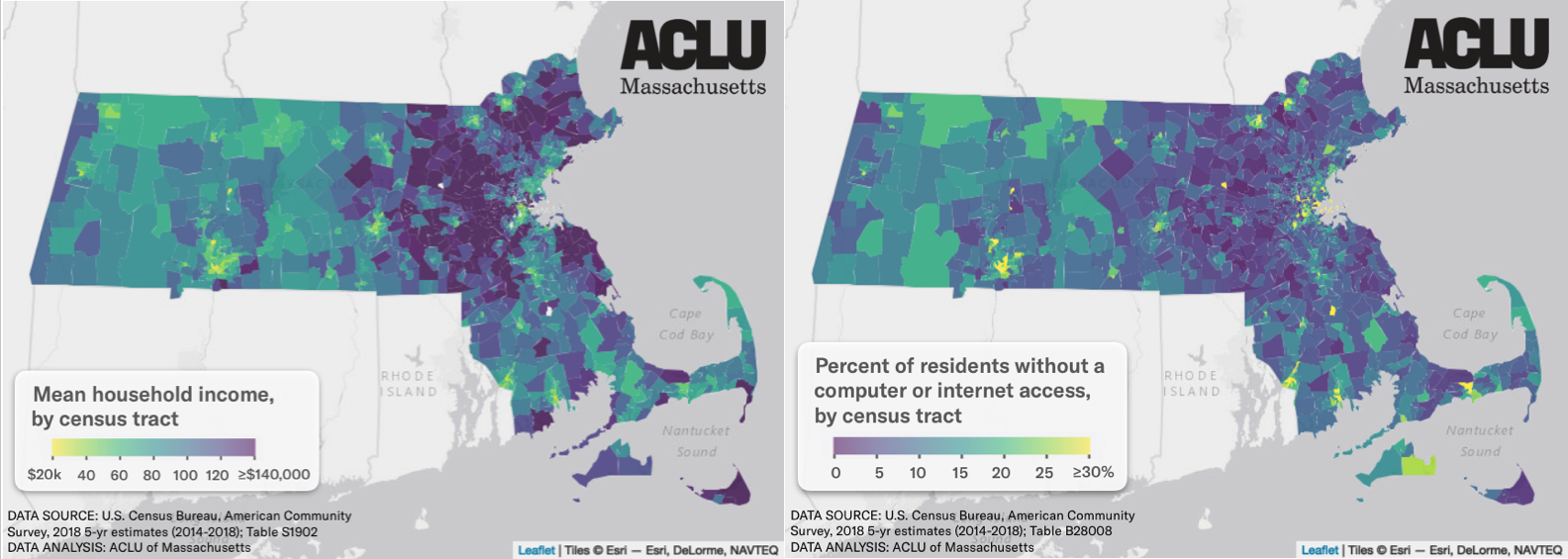
As reported in a previous analysis by the ACLU of Massachusetts, lower rates of internet access or broadband correlate with lower income, both in terms of macroscopic geography (e.g. southern and western Massachusetts), and low-income neighborhoods within cities. 8 cities in Massachusetts have at least 30% of households without cable, DSL or fiber Internet subscriptions in 2018 - Fall River, Springfield, Lowell, Lawrence, Worcester, Lynn, New Bedford and Brockton.
Taking a closer look at Brockton for example: of the households in the lowest two income categories, less than 50 percent have broadband internet access. This is similar to the pattern of better connected cities such as Newton. Here too, about 50 percent of households in the lowest two income categories do not have broadband. Thus from the perspective of a household, one's income is a stronger indicator of access to the internet, even if one is living in an area which generally has robust high speed internet connectivity.
Divest - Reinvest
Bond bill H.4733 singles out certain cities for specific projects. Brockton, for example, is slated to get $2,000,000 for enhanced security camera systems at public housing buildings Campello and Sullivan towers. Instead of investment in broadband, Lawrence, which ranks 28th on the list of 623 worst connected cities in the country, is going to get $2,500,000 for police cruiser technology.Thankfully Springfield, ranked 24 on that list, is slated to get $7,500,000 for a citywide fiber network.
Beyond Education Commissioner Jeff Riley’s testimony on the need of $50 million for remote elementary and secondary education, State and community colleges are in dire need of funding as well. The community colleges’ chief financial officers recently tallied the costs of additional information technology at nearly $17 million.
Rather than expanding the racist carceral state, we should use this Bond Bill to create equitable digital infrastructure to even out the playing field for the future generation.
Unpacking the Boston Police Budget
Explore all of the ACLU of Massachusetts' analysis on policing in the Commonwealth.
In response to the recent egregious murders of George Floyd, Breonna Taylor, Ahmaud Arbery, and Tony McDade, and the nation has seen historic numbers mobilizing and protesting the anti-Black criminal legal system. Advocates across the country have intensified their calls for the government to take action against police abuse, with suggested responses spanning from large-scale defunding to total disbandment of police departments.
Here in Boston, substantial pressure is building to #DefundPolice. Due to monumental organizing efforts by groups such as the Muslim Justice League and Families for Justice as Healing, the Boston City Council received an unprecedented amount of public feedback urging defunding for the June 4 hearing on external grants funding the Boston Police Department (BPD).
Yet these external grants, totaling $2.6 million, are small potatoes compared to the full $414 million the City of Boston has proposed to fund the BPD in Fiscal Year 2020-2021 (FY21), and that the Boston City Council is slated to approve on Wednesday, June 10. Here the ACLU of Massachusetts presents a detailed analysis of how the Boston Police department uses its outsize share of taxpayer dollars.
Access and share this blog published in the form of a report here.
How much money does the BPD get?
The Boston Police Department budget dwarfs that of not only other City departments, but of entire City cabinets (where cabinets administer multiple departments). The FY21 budget proposes a $414 million budget for the Boston Police Department – the second largest line item in the entire city budget, second only to Boston Public Schools.
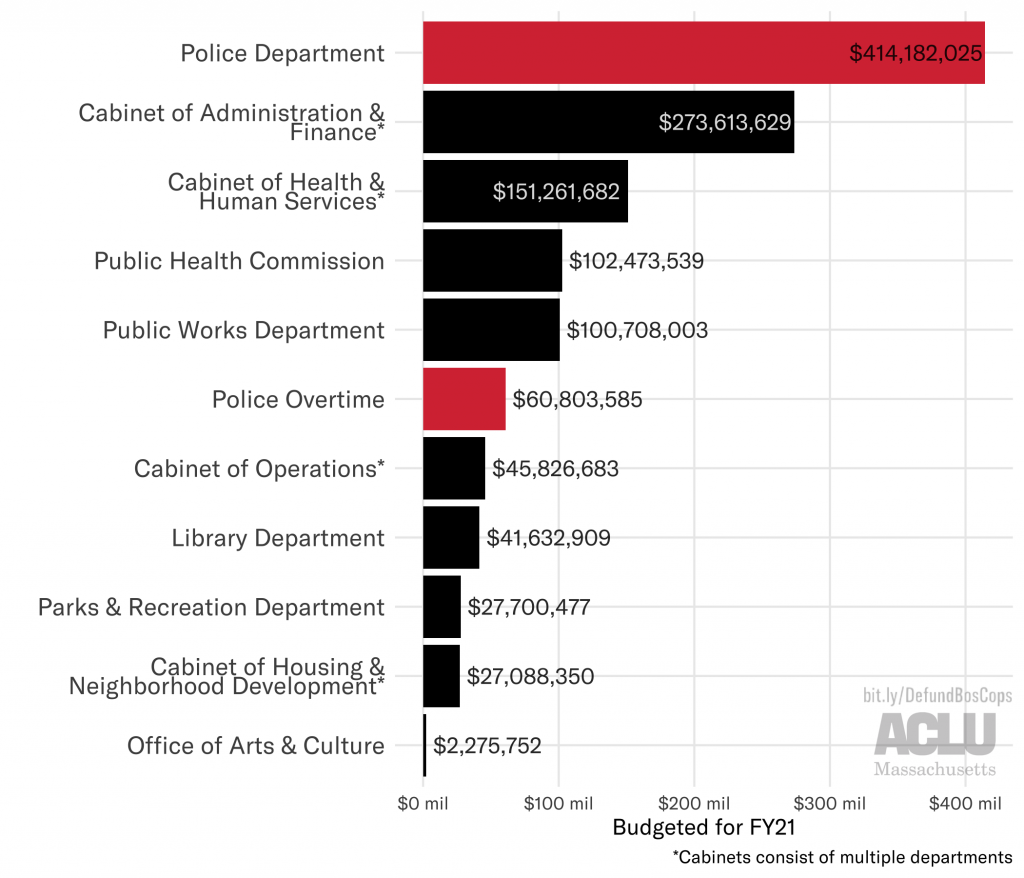
Compared to the budgets of other Boston City departments (and cabinets), the Boston Police budget is:
- 1.5x larger than the Cabinet of Administration and Finance (which constitutes 17 individual departments)
- 2.7x larger than the Cabinet of Health and Human Services (which constitutes 9 individual departments)
- 4x larger than the Public Health Commission
- 10x larger than the Library Department
- 15x larger than the Neighborhood Development Department
- 182x larger than the Office of Arts & Culture
Especially given that we continue to face the worst global pandemic in a century, with no vaccine in sight, the fact that the Boston Police Department expects to receive four times the funding of the Boston Public Health Commission is simply unconscionable.
It’s also important to note that the BPD funding is not limited to what is adopted in the City of Boston’s operating budget. Funding to Boston’s separate Office of Emergency Management and other state and federal grants further deepen the BPD’s proverbial pockets.
What is the FY21 budget changing?
Compared to FY20, the total amount of the BPD budget for FY21 is essentially unchanged. However, funding for personnel is being quietly reallocated within the budget in concerning ways.
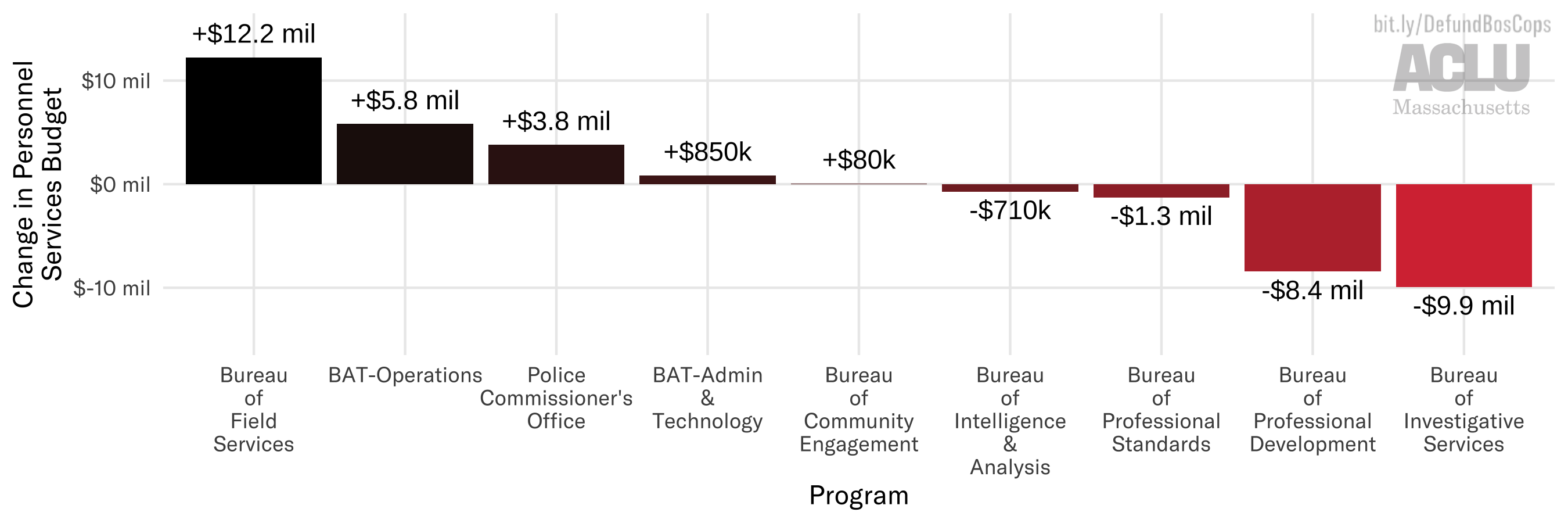
Comparing the different programs within BPD, the Bureau of Field Services is seeing a $12.2 million increase in personnel funding in FY21. This increased funding supports hiring 25 new officers, as well as raises and bonuses for existing officers. At the same time, the Bureau of Professional Standards and the Bureau of Professional Development see personnel cuts of a cumulative $9.7 million.
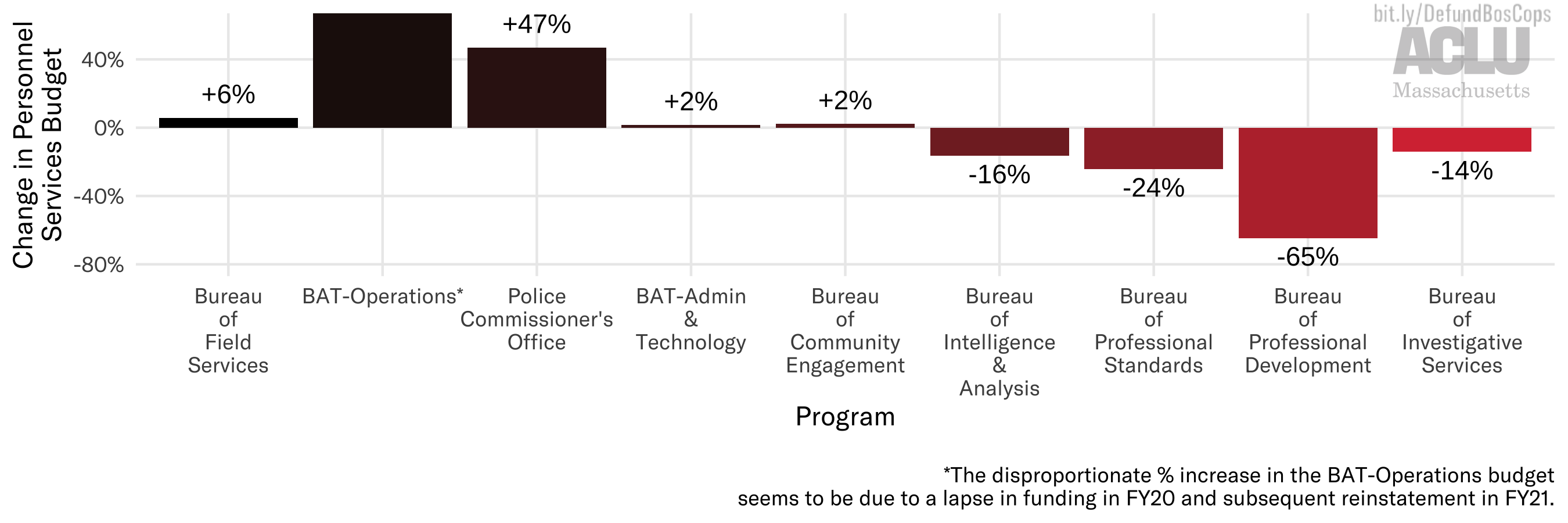
Looking at these raises and cuts as percentages of the FY20 personnel budgets, it becomes clear just how massive these cuts to the professional bureaus are – constituting 24% of the FY20 budget for the Bureau of Professional Standards and 65% of the FY20 funding for the Bureau of Professional Development.
What exactly do these bureaus do? The Bureau of Professional Standards includes the BPD’s Anti-Corruption Division and its Internal Affairs Division; the Bureau of Professional Development includes the Police Academy and Firearms Training programs. Simply put, the BPD programs focused on ensuring professionalism and accountability are being slashed.
How much do BPD employees get paid?
Beyond scrutinizing the City’s funding of the BPD, it is also prudent to examine how these funds are distributed to the Department’s employees, and how BPD’s compensation compares to that of other City officials.
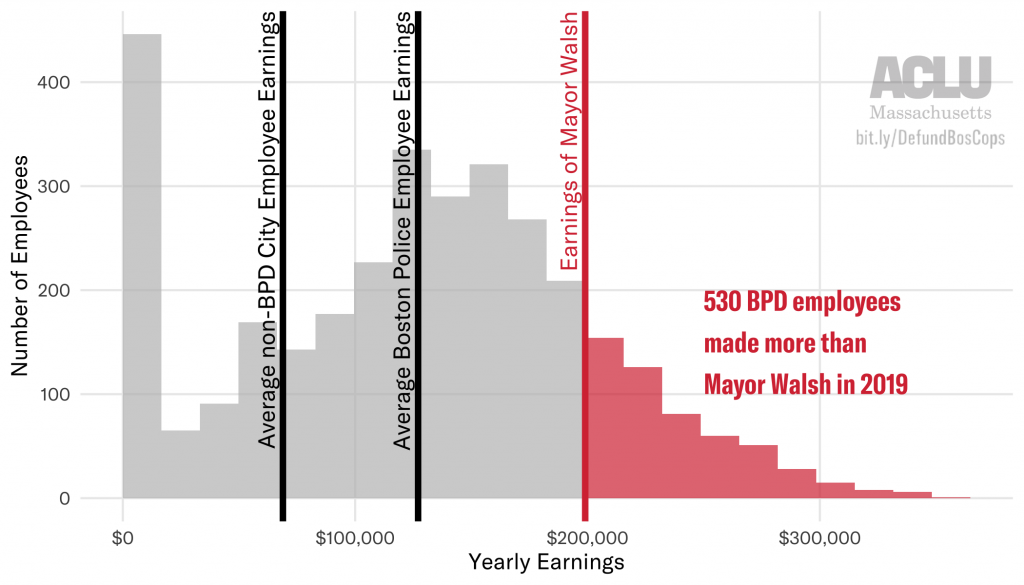
Employee earnings from 2019 show that BPD employees have some of the highest earnings in the entire City of Boston. Indeed, in 2019 the average BPD employee’s yearly earnings were $127,000, while the average non-BPD City employee’s yearly earnings were $69,000 – a whopping difference of $58,000.
Even Boston’s Mayor Marty Walsh can’t compete – 530 BPD employees made more than the mayor’s $199,000 earnings in 2019. All in all, in 2019 BPD employees made up 15 of the top 20 highest-paid Boston employees.
And, concerningly, the vast majority of high-earning BPD employee’s pay seems to come from sources other than their base salary.

None of the highest-earning BPD employees received over 60% of their income from base salary (regular) wages. Overtime, detail, and unspecified “Other” pay categories massively buffer their earnings.
Altogether, the 20 top BPD earners took home $1,971,778 in overtime pay in 2019.
For a great interactive chart showing the earnings of the almost 3,000 people on the BPD payroll, check out this public data viz by Dawn Graham.
What’s that about overtime?
The Boston Police Department estimates its employees will use over 1,200,000 hours of overtime in 2020. Spread over a 52-week year and a workforce of 2898 full-time equivalents (FTEs), 1.2 million hours breaks down to:
- 23,500 overtime hours BPD-wide per week
- 420 overtime hours (2.5 months) per BPD employee per year
- The equivalent of hiring over 570 new full-time employees
And at $60.8 million, the BPD overtime budget makes up 15% of the entire BPD budget. When compared with other Boston City department budgets, the BPD overtime budget alone is:
- 1.3x larger than the Cabinet of Operations (which constitutes 3 individual departments)
- 2x larger than the Parks & Recreation Department
- 11x larger than the Mayor’s Office
- 15x larger than the Cabinet of Civic Engagement
- 240x larger than the Human Rights Commission
This trend is not typical among Boston City employees. Just 7.1% of the earnings of all City of Boston employees were categorized as overtime, yet 18.7% of the BPD earnings came from OT.

This exorbitant overtime pay comes from a number of city and state policies, including an effective monopoly on police operating details at construction sites and a required four-hour minimum pay for any appearance in court.
And what’s more, the BPD have been repeatedly caught fraudulently abusing overtime pay – in 2012, 2016, and 2019.
Where do these data come from?
The data we present here are collected from a number of sources:
- Boston City Council documents
- Packet submitted to the Boston City Council by the BPD in advance of the budget hearing
- Boston City budget website
- Overview of proposed citywide FY21 operating budget
- Boston public safety cabinet (including the office of emergency management, fire department, and police department) adopted FY18-20 and proposed FY21 budget, including line items by accounts payable, list of department personnel & salaries, and list of external funds
- Boston’s open data portal
- Proposed and adopted operating budgets from 2018-2021, broken down by cabinet, department, and program
- City of Boston 2019 employee earnings report
What to do about it
We encourage you to read through the Muslim Justice League’s Defund Boscops Toolkit where they lay out strategy for defunding the Boston Police, including detailed sample testimony.
Some immediate political actions include:
- Call or email Boston Mayor Marty Walsh and Boston City Councilors on the Ways and Means Committee before the final budget vote on Wednesday, June 24, urging them to reject and reduce the current budget’s inflated funding of the BPD
- Tell your Massachusetts legislators to defund police and invest in communities
- Sign a petition to defund Boston police, run by the Youth Justice and Power Union, Roxbury Environmental Empowerment Project, and The City School
- Get involved with a statewide movement to #DefundPrisons with this fantastic toolkit from Families for Justice as Healing and the Building Up People Not Prisons Coalition
Systemic police abuse against Black Americans and peaceful protestors is enabled by massive, unchecked police funding – exactly what we see in the City’s budget for the Boston Police Department.
Now more than ever, we must hold cities, states, and police departments accountable by publicizing the contents of their pocketbooks and urging our legislators to divest and #DefundPolice.
This report and analysis was authored by Lauren Chambers (ACLUM) with the guidance of Kade Crockford (ACLUM) and Fatema Ahmad (MJL).
A previous version of this blog incorrectly cited the final Boston City Council budget vote as being on June 10th. It is actually on June 24th.
Internet Deserts Prevent Remote Learning During COVID-19
Across the country, closures due to COVID-19 are forcing families and schools to take extreme measures just to get students to class, because they lack one essential resource: internet access.
From Michigan to Alabama, Pennsylvania to Oregon, school buses are being transformed into roving wi-fi hotspots. Some rural students have no choice but to drive miles to sit in parking lots of fast food restaurants and churches in order to access the internet. In Fort Worth, Texas, a school district bought three transmission towers for $600,000.
Here in Massachusetts, school districts reports show that while wealthy regions like Andover report online student participation around 95 percent, lower income areas like Chelsea are seeing attendance as low as 30 percent.
Many school districts such as Springfield and Chicopee have distributed technology, like laptops and tablets, to students. However, a laptop without internet is just as useful for modern schoolwork as a car without gas is for driving. Without the final piece of the puzzle, it’s just a glorified hunk of metal.
Using data from the Census’ American Community Survey, the ACLU of Massachusetts presents analysis of internet and computer access across the Commonwealth. We show that many urban and rural areas in Massachusetts are “internet deserts”, where access is severely limited.
Learn More: Visit our interactive site which allows detailed exploration of internet access and related social factors across Massachusetts.
Hotspots without computer or internet access
According to estimates from 2014-2018 census data, over 500,000 Massachusetts residents either do not have a computer or, while having a computer, do not have access to the internet. Statewide, this represents 8 percent of all Massachusetts residents. However, in certain regions in the Commonwealth – so-called internet deserts – over 25 percent of residents, 1 in 4, do not have a computer or internet access.
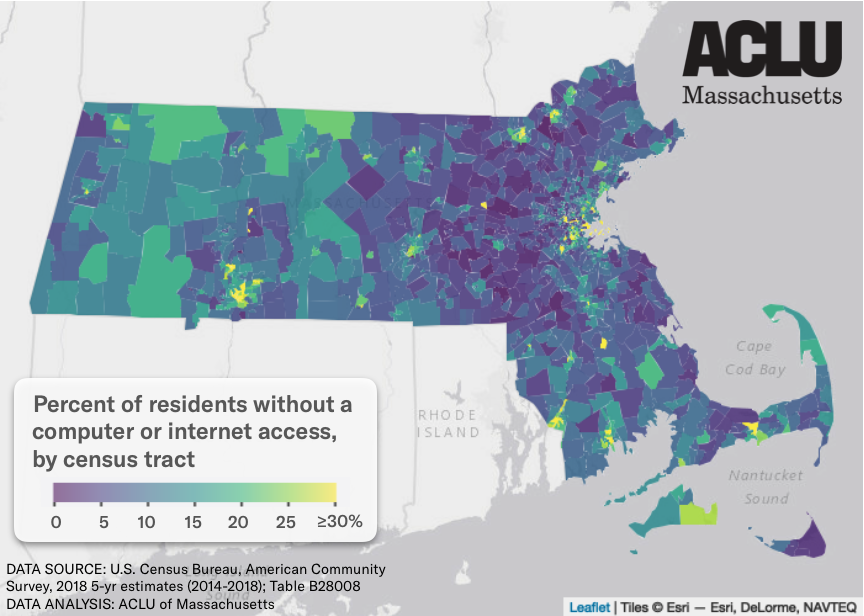
Massachusetts’ urban areas, including Boston, Lowell, Lawrence, Worcester, Springfield, and Northampton, all have neighborhoods in which over 30 percent of residents live without wi-fi. But rural areas are affected as well: northwestern and southwestern Massachusetts also have large regions where almost 20 percent (1 in 5) of folks don’t have access.
Even more without broadband internet
However, not all internet is created equal. High-speed broadband internet connections, rather than slower dial-up, are necessary for effective use of video conferencing software. Without broadband, remote students may have extra technical difficulties which prevent their participation in school.
Census estimates show that more than 1 million Massachusetts residents, over 15 percent, do not have a fixed broadband internet connection.
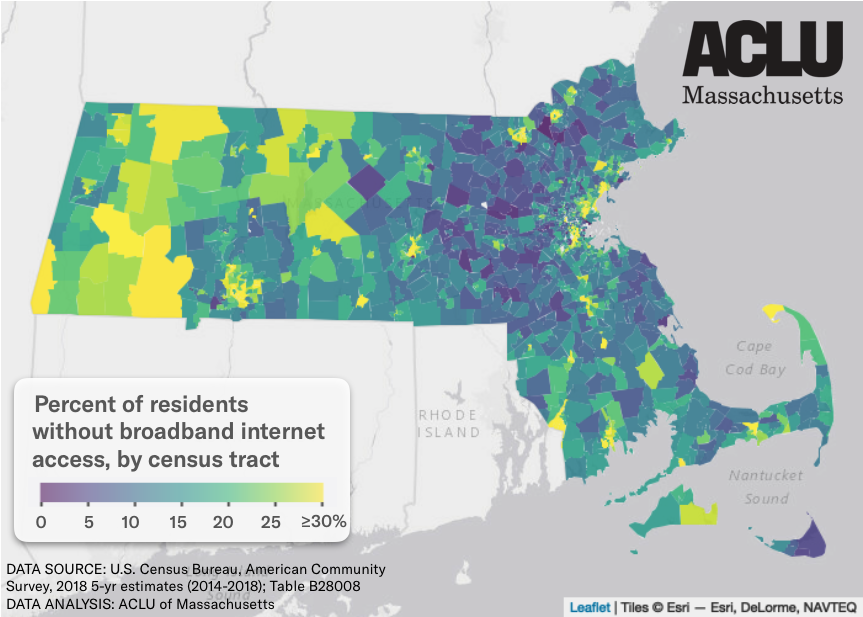
Again, localized areas see much higher rates: all major Massachusetts cities and large swaths of rural Western Massachusetts contain regions where over 30 percent of residents have no reliable broadband wi-fi.
Low-income areas are the most disconnected
Of course, unequal access arises from the fact that internet subscriptions cost money. Census analysis shows that internet and computer access correlate with income, such that areas with higher income communities enjoy more widespread access, while lower income neighborhoods are disproportionately left unconnected.

In the extreme era of COVID-19, it’s important to note that this analysis uses income estimates from up to only 2018. The global economic downturn and widespread job losses caused by the pandemic mean that many households are now earning much less than they did in 2018, and thus presumably even more households are going without wi-fi.
Tens of thousands of students offline
Further analysis breaking down estimates of internet access by age reveals that over 60,000 people under the age of 18 in Massachusetts, around 4 percent of all minors, have no computer or internet access at home.
Indeed, in multiple school districts across the state more than 20 percent of minors have no access to wi-fi, including those already shown to be located within internet deserts: Springfield, Lowell, Lawrence, and Petersham School Districts (Worcester).
What about your town?
Use this interactive map to explore internet access and income across Massachusetts:
As the ACLU of Massachusetts emphasized in a recent letter to the Commonwealth’s Department of Elementary and Secondary Education (DESE): unequal education isn’t just unacceptable; it’s unlawful.
DESE must take action to increase resources in low income school districts. Some individual districts, including Amherst, Chicopee, and Holyoke have set examples by providing mobile hotspots to families and securing deals with internet providers to get students free access. Now the state, too, must step up to ensure all students have access to not only computers and tablets but all of the following as well:
- Functional microphones and webcams
- Broadband internet supportive of remote video meetings
- Hardware and infrastructure required for an internet connection (e.g. cable line, modem, & router)
- Communications platforms free of charge
- Assistive technology including but not limited to screen readers, live closed captioning, and speech-to-text software for students with disabilities
- Software and websites compliant with the Web Content Accessibility Guidelines (WCAG)
- Privacy assurances for all software and devices
- Instructions written in plain English and appropriate non-English languages, such that students’ families understand and can support remote learning efforts
The Massachusetts Constitution requires that the Commonwealth provide adequate education to all students. And while remote learning is certainly a necessary measure in promoting public health, the current state of affairs means far too many Massachusetts students are now home without even the basic infrastructure for academic participation.
Incarcerated and in Danger: COVID-19 in Massachusetts Prisons & Jails
While the COVID-19 pandemic poses a massive threat to the general population, imprisoned populations face even higher risks due to close living quarters, poor hygiene, and inadequate medical attention.
On April 3, 2020, the Supreme Judicial Court of Massachusetts (SJC) in Committee for Public Counsel Services (CPCS) v. Chief Justice of the Trial Court, SJC-12926 issued an order that will help some incarcerated people in Massachusetts seeking release in response to the threat of COVID-19. Per its decision, the Court now allows some people detained pre-trial to request a hearing for their release where they will be entitled to a rebuttable presumption of release. The Court also ordered daily reports from prisons, jails, and houses of corrections across the state.
Each day, these reports document how many COVID-19 tests are performed on prisoners and staff, how many tests return positive, and how many people are released from confinement pursuant to the Court’s decision. Analysts and developers at the ACLU of Massachusetts have developed a new interactive tracking portal to make these data available to the public and perform preliminary analysis of trends.*
Here we present four major takeaways from the first week of reports, illustrating that Massachusetts prisoners already face an exceptional threat due to COVID-19.
1. COVID-19 cases are skyrocketing in prisons and jails
Statewide, the number of positive COVID-19 cases inside prisons and jails is increasing at a terrifying rate. In just one week, the total number of reported positive cases increased over 200 percent, from 93 prisoners and prison staff who had tested positive by April 6 to 281 positive tests by April 14.

State Department of Correction (DOC) facilities alone account for 62 percent of all cases, reporting 158 positive cases by April 14.
Certain individual facilities have become frightening hotspots, too, with positive cases in Essex County increasing 375 percent from 9 cases on April 6 to 43 cases on April 14. And at the Massachusetts Correctional Institution in Framingham, over 10 percent of prisoners have tested positive for COVID-19.
2. Rates of COVID-19 inside prisons and jails are much worse than statewide
As of April 14, the COVID-19 incidence rate among all prisoners incarcerated in Massachusetts is 104 reported positive cases per 10,000 prisoners. In DOC facilities, the situation is even more dire, with a case incidence rate of 120 reported positive cases per 10,000 prisoners.
For comparison, on April 14 Massachusetts reported a statewide case incidence rate of 41 reported positive cases per 10,000 residents. This means the incidence rate of COVID-19 among prisoners within correctional facilities is over two times higher than the statewide rate.
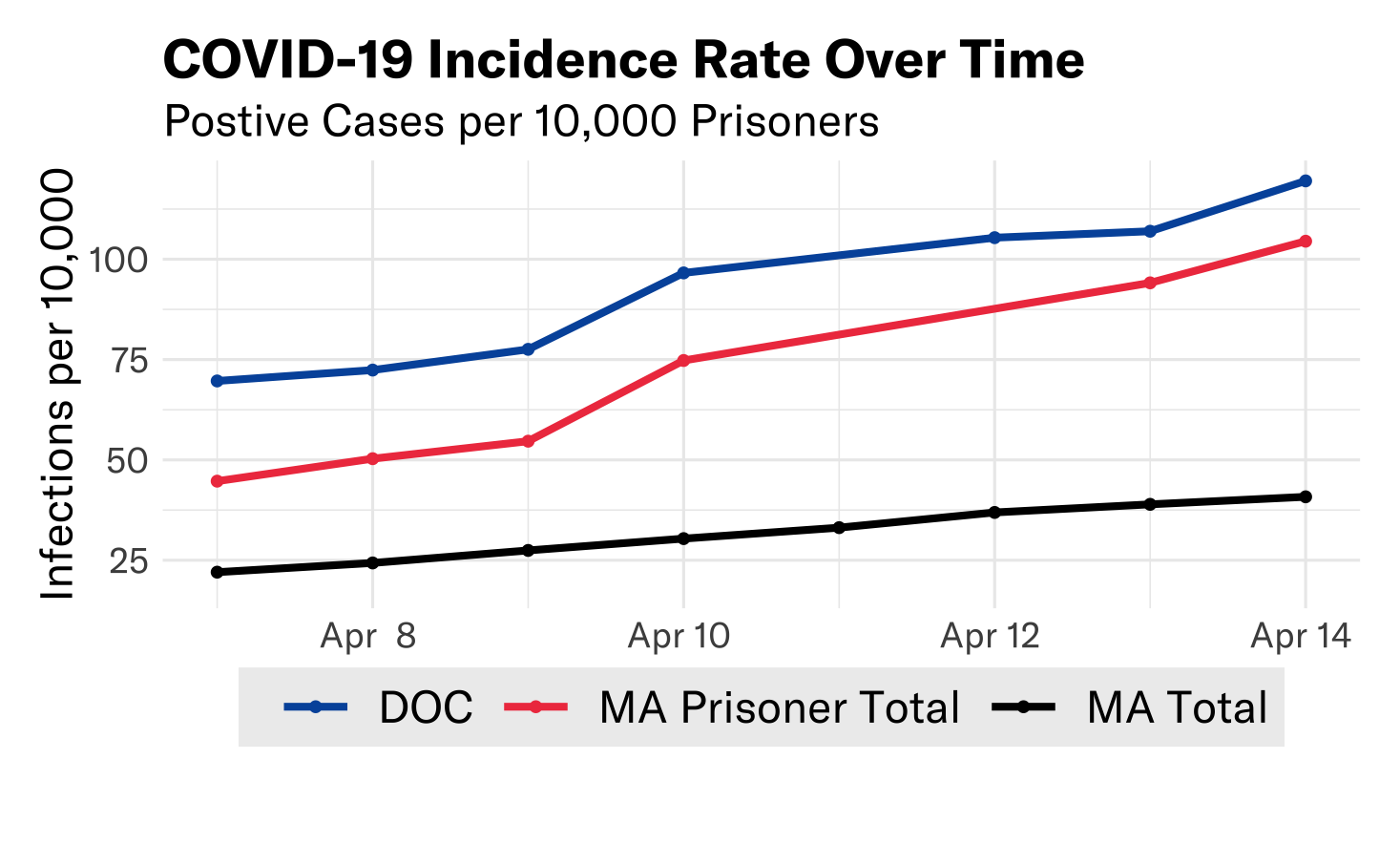 Yet looking to criminal justice facilities nationwide, it is clear that things can get much, much worse. According to the Legal Aid Society, the COVID-19 incidence rate at Riker’s Island Prison in New York City was 814 reported positive cases per 10,000 people on April 14.
Yet looking to criminal justice facilities nationwide, it is clear that things can get much, much worse. According to the Legal Aid Society, the COVID-19 incidence rate at Riker’s Island Prison in New York City was 814 reported positive cases per 10,000 people on April 14.
The meteoric increase of cases in Massachusetts facilities suggest we might reach similarly astronomical numbers soon – unless courts and criminal legal system officials take immediate action.
3. Testing in some MA prisons and jails is abysmal
Access to COVID-19 tests in the United States is insufficient nationwide, and the situation is even worse within Massachusetts county jails.
Multiple county sheriffs have not reported testing a single prisoner for COVID-19 since at least April 5. Such counties include Barnstable and Franklin Counties, whose correctional facilities together incarcerate over 300 people.
Other counties have reported testing at unacceptably low rates: Bristol County has administered a COVID-19 test to just 1 of its over 600 prisoners (0.2%); Norfolk County has tested just 3 of 368 (0.8%); Plymouth County, 4 of 744 (0.5%).

Compare this to testing rates across Massachusetts, where 126,551 tests have been administered as of April 14, for a statewide testing rate of 1.8 percent.
Tests of jail employees, including correctional officers, contractors, and other staff, are lacking as well. Bristol County and Suffolk County have not reported administering a single COVID-19 test to any of its staff, again since at least April 5.
Altogether, the positive rate of tests performed on all prisoners and staff is 49 percent (281 positives from 578 tests). This massively inflated rate reflects not only that COVID-19 is running rampant within prisons and jails, but also that nowhere near enough tests are being performed to inform proactive decisions; these facilities are playing whack-a-mole with prisoners’ and correctional officers’ lives.
4. SJC decision leads to some prisoners released – but not nearly enough
Some good news is that the Supreme Judicial Court decision has indeed led to the release of some people from incarceration. As reported to the Court, 366 prisoners have been released pursuant to the ruling in SJC 12926. Of these, over 80 percent are releases of pre-trial detainees who have not been convicted.
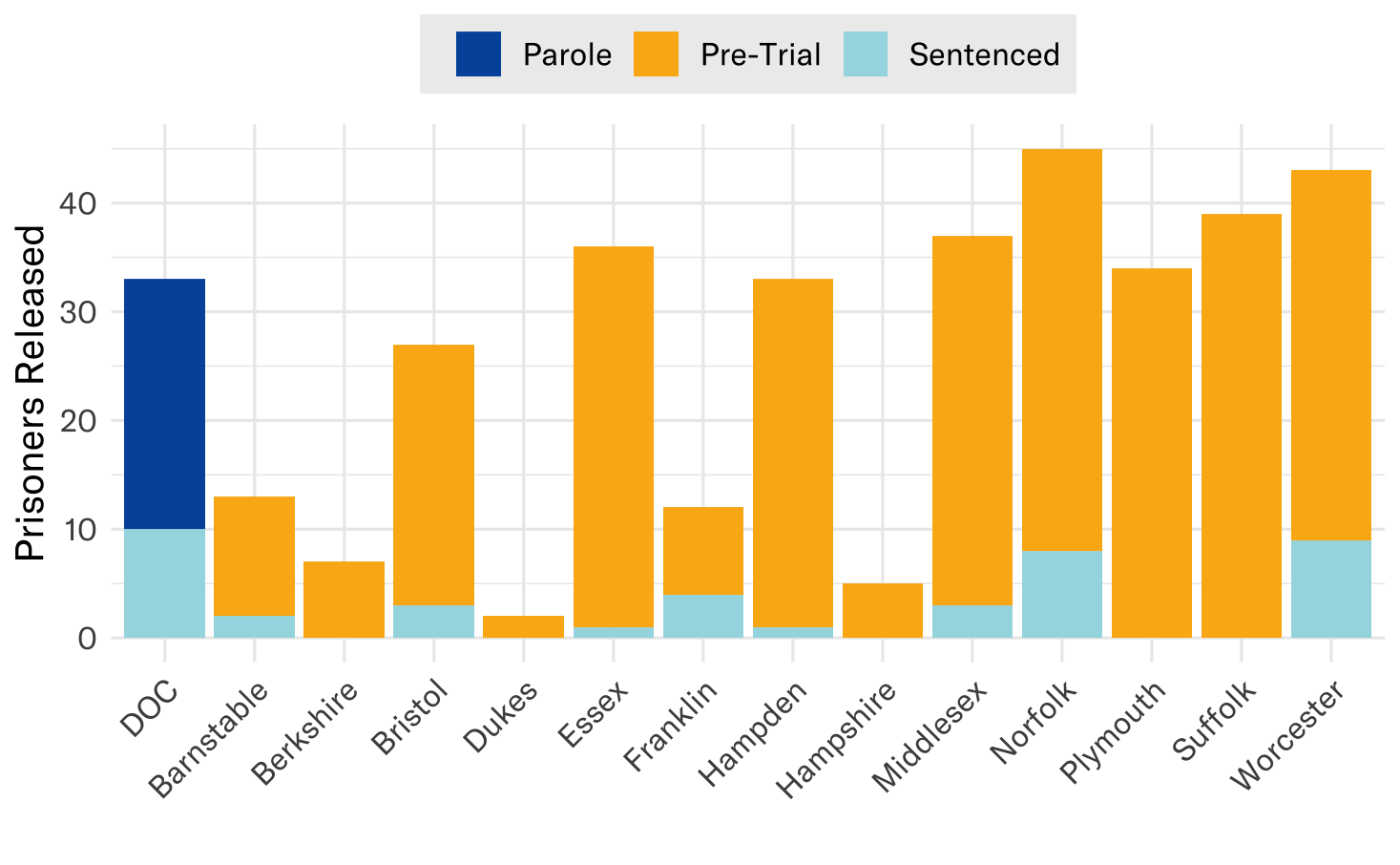
This result is significant for these 366 people and their loved ones. But releasing such a small number of people will not stop the crisis from overtaking our prisons and jails—putting incarcerated people, prison and jail staff, and the entire community at greater risk of infection and death.
This is why, in an open letter to public officials on March 18, the ACLU of Massachusetts urged Governor Baker to grant emergency commutations for “people whose sentence would end in the next year, to anyone currently being held on a technical supervision violation, and to anyone identified by the CDC as particularly vulnerable whose sentence would end in the next two years.” Neither the Supreme Judicial Court nor the governor have acted yet in favor of release for such sentenced prisoners, and only 41 sentenced prisoners have been released.
Governor Baker can and must protect these vulnerable individuals, or they will remain trapped inside increasingly dangerous facilities with no available options for recourse, and many will die.
The best available data on COVID-19 in Massachusetts prisons and jails suggest that many facilities are death traps where inmates and staff alike suffer from skyrocketing rates of infection and insufficient testing.
In a new letter submitted on April 14, the ACLU of Massachusetts and the Massachusetts Public Health Association once again urged the Governor to take action to release incarcerated individuals in the face of pandemic, by (1) ordering the Parole Board to expedite previously-made parole decisions for hundreds of people who have been granted parole but have not yet been released; (2) amending the Executive Clemency Guidelines in light of the pandemic and (3) directing the Advisory Board of Pardons to expedite the processing of pending clemency petitions.
As the Petitioners in CPCS v. Chief Justice of the Trial Court explained in their emergency petition to the Court on March 24, "There are about 16,500 human beings in our prisons and jails. None of them have been sentenced to death. Yet, without aggressive and immediate intervention, COVID-19 will likely kill many of them."
Four prisoners have died of COVID-19 in Massachusetts since that emergency petition was filed. We don’t need to wait for that number to climb higher before declaring a crisis within our prisons and jails. Unfortunately, the data show that crisis is already here. The time to act is now.
*The Special Master in CPCS v. Chief Justice of the Trial Court released a report on April 14th publishing data that conflict with data reported here and in our web tracker. The ACLU of Massachusetts is aware of the disparities, understands their causes, and is in the process of communicating with the Special Master to resolve the issue.


